Abstract
For millennia the ancient Egyptians filled their tombs and temples with stone sculpture. Egyptian stone workers were extremely prolific, quarrying vast quantities of stone from along the Nile Valley and the deserts beyond, and turning it into sculpture ranging from miniature to monumental. Particularly impressive is their exploitation of hard stones, such as granite, granodiorite, graywacke, anorthositic gneiss, or basalt. Although secondary sources including tomb paintings and excavated tools provide insight into hard stone working methods, there is significant disagreement among scholars about the forms and materials of the tools themselves, how they were used by ancient stoneworkers, and how these factors relate to the broad range of surface textures we observe. This paper seeks to demonstrate the utility in addressing these questions through the systematic characterization of tool marks using Reflectance Transformation Imaging (RTI), augmented by the examination of ancient tools, experimental archaeology, and consultation with contemporary stone carvers. This approach is demonstrated through a series of case studies which illustrate useful comparisons between tool marks on Egyptian stone sculpture in the collection of The Metropolitan Museum of Art. Topics addressed include: differences in hard stone and soft stone carving; variations in finishing work on statuary elements; variations in the carving of hieroglyphs; and possible evidence of a changing tool kit.
1. Introduction
For millennia ancient Egyptians quarried vast quantities of stone from the Nile Valley and the deserts beyond, and turned it into sculpture ranging from miniature to monumental. Particularly impressive is their exploitation of hard stones, such as granite, granodiorite, graywacke, anorthositic gneiss or basalt. While tomb paintings can provide some insight into hard stone working methods, there is significant disagreement among scholars about the forms and materials of the tools themselves, how they were used by ancient stoneworkers, and how these factors relate to the broad range of surface textures we observe. This paper addresses these questions through a systematic characterization of the tool marks remaining on the objects’ surfaces.
The need for an in-depth study of tool marks on stone sculpture, particularly for the benefit of authenticity studies, has already been noted,1 and the case studies presented in this paper come out of a multidisciplinary research project addressing this gap in scholarship. Open questions about the forms and materials of the tools themselves and the processes used by ancient stoneworkers to produce a wide range of surface textures were explored through the following methods: documentation of tool marks with Reflectance Transformation Imaging (RTI); examination of ancient tools; experimental archaeology; and consultation with stone carvers.2 This paper will largely focus on the evaluation of imaging results, presenting case studies that illustrate useful comparisons between tool marks observed and recorded on Egyptian stone sculpture in the collection of The Metropolitan Museum of Art. The specific objects explored in this paper are relatively small-scale sculptures, and although the means of their production undoubtedly has overlap with large-scale sculpture, lapidary work, architecture, and stone vessel production, I have attempted to limit the number of variables explored. Most of the objects included in this study were excavated by The Met in the early 20th century.
My observations are grounded in a comprehensive review of previous scholarly work,3 and are especially indebted to the work of Peter Rockwell and Denys Stocks. Stocks’ in-depth exploration of Egyptian stoneworking technology takes into consideration environmental factors, natural resources, evaluation of unfinished artifacts and existing tools, as well as other archaeological and pictorial evidence, and combines this research with experimental work.4 Rockwell, a traditionally trained sculptor and expert on the history of the craft, published important works on stone carving technology5 and taught this subject extensively. I had the privilege of learning from him first-hand through an independent study and then as a Fellow at the American Academy in Rome. My assessment of tool marks builds on Rockwell’s comprehensive tool mark analysis, some of which has been recorded in The Art of Making in Antiquity: Stoneworking in the Roman World (https://artofmaking.ac.uk/), a web feature on which he collaborated. Although little of Rockwell’s published work deals directly with stone carving in ancient Egypt, the methodology he employed is broadly applicable. Indeed, in their essay on stoneworking tools and tool marks for the website The Art of Making in Antiquity, Wootton, Russell and Rockwell observed that “practitioners are often the best guides for interpreting toolmarks on ancient carvings and how these were made because they are used to working in a wide variety of stones and are aware of the ranges of tools in existence.”6
I collaborated with Rockwell on a series of experiments in soft and hard stone carving, most of which were based on the previous experiments of Zuber7 and Stocks. In fact, many assumptions about stone carving tools and methods are based at least in part on replication experiments and the observation of contemporary workshop practice. Replication experiments can be invaluable in informing our understanding of ancient technology. Craft production is simultaneously a visual, audio and tactile experience, and while we might be able to understand the
2. An Overview of Egyptian Stone Carving Materials, Tools and Methods
When looking at tool marks it is important to understand the physical properties of the substrate. Hardness and homogeneity are critical factors that inform how and with what a stone can be carved.10 In this paper, as in most literature on the subject, the term “soft stone” is used to describe stones such as limestone, sandstone and steatite which have an equivalent scratch hardness of 3 or below on the Mohs Scale.11 Stones such as indurated limestone, graywacke, granite, granodiorite and silicified sandstone, which have an equivalent scratch hardness that is greater than 3 on the Mohs Scale, are classified as “hard stones”. However, these categories are not rigid and can vary based on the geological origin of the stone. For example, as will be discussed later, serpentinite is classified by Aston, Harrell and Shaw as a hard stone, but, according to Klemm and Klemm, Egyptian serpentinite has a hardness equivalent to that of calcite, which is Mohs 3. Of equal importance is the recognition that the Mohs scale was developed for assessing mineral hardness; the equivalent Mohs hardness of a rock reflects that rock’s cohesiveness, and may have little to do with the hardness of the minerals that compose it.12
Scratch hardness is a useful determination when discussing the ease with which a stone is carved, but I am not aware of any systematic study of the scratch hardness of Egyptian stone types. Where Mohs numbers are presented in this paper, it should be noted that they come from literature references where the method used to calculate the Mohs number is not reported.
Nina de Garis Davies (1881–1965). Sculptors at Work, Tomb of Rekhmire, Dynasty 18, ca. 1479–1425 BCE. Original from Egypt, Upper Egypt, Thebes, Sheikh Abd el-Qurna, Tomb of Rekhmire (TT 100). Tempera on paper, facsimile: h. 54 cm (21 1/4 in); w. 38.5 cm (15 3/16 in) scale 1:1. The Metropolitan Museum of Art, Rogers Fund, 1930 (30.4.90).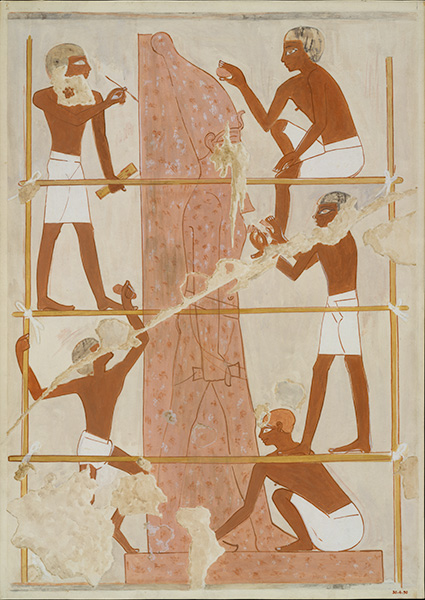
This paper focuses predominantly on the implications of tool marks on our understanding of tool kits and carving methodology. Much has been written on quarrying methods,13 the extent to which statues were carved at the quarry site,14 what can be learned about sculpture production through the study of the few urban workshops that are known to us,15 and stone-working debris at building sites.16 However, Stocks notes the difficulty in assessing the chronological development of ancient Egyptian technology, especially because we don’t know if there are any tools missing from the archaeological record.17 Painted depictions of sculptors at work, such as that represented in Fig. 1, provide insight about tool form and use, but it has been generally acknowledged that these images are not always reliable sources for technological information – Egyptians tend to show statues in their finished state, even when they are at an early stage in the sculptural process.18
Percussive tools take a variety of forms: they can be simply held and struck against a stone surface, they can be mounted to a handle and wielded, or they can be held and struck with a mallet.
They include pounders, axes, mauls, adzes and chisels19 and they either cut or fracture the stone, depending on the form of the tool and the nature of the stone. Abrasive tools include grinders, rubbers, scrapers and loose abrasive particles or abrasive slurries used on their own or with saws and drills.
a) Stone mason’s chisel and mallet; chisel: Middle Kingdom, Dynasty 11, reign of Mentuhotep II, ca. 2051-2000 BCE. Egypt, Thebes, Deir el-Bahri, Tomb MMA 101, in front of chamber 3 west, MMA excavations, 1926–27. Hammered bronze or copper alloy, L. 19.5 cm, W. 2.2 cm. The Metropolitan Museum of Art, Rogers Fund, 1927 (27.3.12); mallet: Middle Kingdom, Dynasty 12, reign of Senwosret I, ca. 1961–1917 BCE. Egypt, Memphite Region, Lisht South, Pyramid Temple of Senwosret I, MMA excavations. Wood, H. 28 cm, W. 15 cm. The Metropolitan Museum of Art, Rogers Fund and Edward S. Harkness Gift, 1924 (24.1.76). b) Scraper, probably New Kingdom, Ramesside – Third Intermediate Period, ca. 1184–664 BCE. Egypt, Memphite Region, Lisht North, MMA excavations. Flint, L. 4.5, W. 3.2cm. The Metropolitan Museum of Art, Rogers Fund, 1948 (48.105.38n). c) Grinding stone, New Kingdom, Ramesside, Dynasty 19–20, ca. 1295–1070 BCE. From Egypt, Memphite Region, Lisht North, Late New Kingdom Settlement, MMA excavations, 1906–08. Silicified sandstone (?), L. 9 cm. The Metropolitan Museum of Art, Rogers Fund, 1915 (15.3.1717).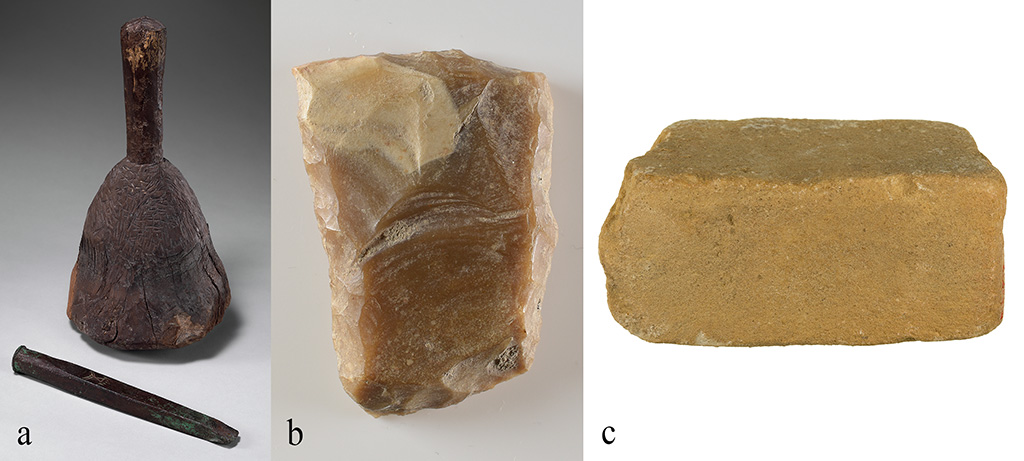
In the Predynastic Period, craftspeople employed stone tools, including axes, adzes and grinders; these tools were predominantly used in the prolific stone vessel industry. Skills honed in this era were integral to early experimentation with hard stone carving in the Early Dynastic Period20 and the proliferation of statuary production in the Old Kingdom. Cast copper tools first appear from Nagada II,21 and Petrie suggested that certain stone tools were imitated in copper.22 However, copper and bronze tools, such as adzes and chisels,23 were almost certainly used exclusively for the working of soft stones like limestone. My experimental work,24 and that of Zuber and Stocks, demonstrates that percussive tools made from copper or bronze are ineffective on hard stone, suggesting instead the use of stone percussive tools.
Mauls, hammers and pounders made from dense hard stones would have been used for rough shaping and creating flat surfaces. Interestingly, Arnold notes that Incan stone workers in 15th-century South America dressed their granite, porphyry and andesite with practically the same tools.25 These tools varied in shape and size and were used for almost the entire carving process. The marks left by this category of tools generally appear as shallow pits or depressions, formed as the stone is shattered or fractured from impact. The worked surface always has contiguous depressions, most often with no discernible direction.26
Fine carving, on the other hand, was likely done with chisels made from flint.27 Although flint tools definitively
While it is likely that the use of flint tools extended well in to the first millennium, the place of iron tools in this narrative is still debated. Arnold notes that by the 26th Dynasty iron was as common a material as bronze, and he believes that tool marks indicative of iron can be seen on hard stone at this time33 while Devaux writes that iron tools capable of working hard stones come into use in the 27th Dynasty.34 Stocks, on the other hand, argues that Late Period iron chisels could not have been used to cut hard stone, and that flint tools were still used for this task.35 Despite disagreement about the exact timing of this technological shift, there is evidence that the process for making quenched and tempered steel was known in the Mediterranean region by the 7th century BCE, and this would have had significant impact on the utility of metal tools on hard stones.
Regardless of the type of percussive tool used, it is clear that abrasive methods were especially crucial for the working of hard stones, not just to impart the desired surface but also for rough shaping. Copper drills and saws first appear in the Old Kingdom, and these were used in combination with an abrasive slurry for cutting hard stones.36 In fact, it is highly likely, from an efficiency perspective, that a significant amount of stone removal and rough shaping were accomplished with abrasive technology. Finishing was likely carried out with a combination of rubbing or grinding stones37 and abrasive slurries. Rubbing or grinding stones were often made from silicified sandstone38 and other stones with a high quartz content. The composition of the abrasive materials used has been extensively debated:39 were hard stones shaped and polished using solely quartz-based abrasives, or did the Egyptians have access to harder materials? It has been demonstrated through archaeological evidence and experimental data40 that corundum, a mineral with a hardness of Mohs 9, and emery, a stone containing corundum minerals, were employed by craftsmen in the ancient Mediterranean and Near East, but were these materials part of the Egyptian tool kit? Although some scholars have posited the use of emery abrasive powder,41 this was countered by others citing the lack of direct evidence for the use of this material in Egypt, as well as the lack of known sources of emery in Egypt and the presence of quartz sand embedded in ancient drill holes.42 However, abundant corundum particles were found in the base of a drill hole in a small fragment of indurated limestone (57.180.142), excavated at the Great Temple of the Aten at Amarna.43 These particles were mixed with powdered limestone, and corroded fragments of a bronze drilling tool. This discovery suggests that corundum could have been introduced as an abrasive material by 1350 BCE, but in order to draw any inferences about the implications of this on sculpture production more data points are necessary.
In terms of methodology, unfinished statuary demonstrates that the basic sculptural process was to rough out a cube of stone, execute preliminary drawings on all sides, and then to work inwards from each side.44 Thinking specifically about hard stone statuary, Rockwell cites the unfinished seated statues of Mycerinus in the MFA Boston, the carving of which is also discussed in detail by Devaux.45 They are carved in “a hard-stone technique, whereby the stone is removed by vertical pounding so that it is shattered into small bits as the carver moves over the surface. The surface is pitted, and the pitting becomes finer and finer as the carving nears completion.”46 Rockwell compares these third millennium statues with unfinished works from the second and first millennia.47 All of the statues demonstrate a method in which the form evolves using a sequence of progressively more complex geometric solids. The
An equally important methodological point relates to tool usage. Rockwell notes that granite is often worked by holding a tool vertical to the stone and smashing it. Therefore, tools are thicker and blunter than those for softer stones and must be sharpened or re-forged more often.49 Rockwell was referring to granite carving after pharaonic Egypt – should we assume that flint chisels were used in the same manner? The mechanism by which a tool is used to remove stone has direct bearing on the tool marks left behind, as does the material from which a tool is made, its shape, and the methodological approach that the carver takes to realize the finished work. This is the salient point when assessing a stone sculpture from a technical perspective, whether one’s interest is in the relative effort that went into an object’s production, workshop practice, or authenticity. What can tool marks tell us? Does an iron chisel bruise the stone differently than flint? What is the difference between abrasive marks from quartz and harder minerals like corundum? What is the relationship between tool marks on a surface and how can we use this relationship to make observations about tool usage and methodology? As Rockwell writes, “[i]n a technology where the written documentation is scarce and often confusing, or written by those who were not familiar with it, usually the only accurate evidence is the object itself.”50
3. Documenting Tool Marks
Most investigations of tool marks on stone present them either using conventional photography or SEM images of silicone rubber impressions. The merits and drawbacks of these methods have been previously discussed,51 and on this basis, RTI was used here as the primary method for visual analysis and documentation.52 With RTI, a series of high-resolution images, each with distinct information about highlights and shadows, are synthesized to create interactive image files. RTI reveals texture and detail that are often difficult to see with the naked eye or challenging to record due to an object’s optical properties. Color and shape information are encoded in each pixel, allowing the user to re-light the object from an infinite number of angles and facilitating the mathematical enhancement of surface features.53
All images presented in this paper are exported from RTI files that were generated using the Highlight-based RTI Capture and Processing methods published by Cultural Heritage Imaging (CHI).54 RTI data sets were captured using a Canon 5D Mark II DSLR with a Canon 100mm f/2.8L Macro lens. The light source was a Canon speedlight that was triggered with a remote transmitter mounted on the lens and a hand-held remote. Enhancement modes applied in RTIViewer are noted in the caption of each image. The two enhancement modes found to be most useful for visualizing the surfaces of the objects presented in this paper are specular enhancement55 and coefficient unsharp masking.56
The visualizations generated through this relatively inexpensive, readily available technique are qualitative and their limitations must be recognized,57 but if executed according to CHI Guidelines RTI can reduce some of the subjectivity of standard photography and can be highly accurate and reproduceable.58
4. Reading Ancient Sculpture: Case Studies
In the process of recording tool marks on a wide range of stone objects, several interesting threads of inquiry emerged: differences in hard stone and soft stone carving; variations in finishing work on statuary elements; variations in the carving of hieroglyphs; and possible evidence of a changing tool kit. I explore these topics below through a series of case studies which lay out a methodology for the exploration of stone carving tools and technology. The objects presented here come from a range of time periods and vary in place of origin and function. The majority are from the collection of The Metropolitan
It should also be noted that the stone identifications presented in this paper have most often been carried out by visual examination rather than scientific analysis. In general, the misindentification of stone types in museum labels and publications is common. The stone identifications in this paper are most often based on visual characteristics and comparison with scientifically identified samples and relevant literature, in consultation with geologists. Detailed petrographic classification would require the preparation and analysis of thin sections.
4.1 Soft Stone vs. Hard Stone
When investigating tool marks as evidence of technique, establishing the observable differences between hard and soft stone carving is the first step. As has been previously noted, approaches to soft and hard stone carving must have differed vastly. Indeed, in Egypt, as in other ancient cultures, the carving of hard stone was likely a particular specialization with dedicated craftspeople.59 On a visit to the Nicoli workshop in Carrara, I was introduced first to the team of sculptors who worked with marble and then to the team of sculptors who worked with granite. Although extrapolating ancient methods from contemporary practice should be done with caution, this split between practitioners in this 150-year-old workshop is worth noting.
Upper part of the statue of a man, Middle Kingdom, Dynasty 12–13, ca. 1981–1640 BCE. Egypt, Memphite Region, Lisht North, MMA excavations, 1906–07. Serpentinite, H.6.7 cm, W.6.5 cm. The Metropolitan Museum of Art, Rogers Fund, 1915 (15.3.579).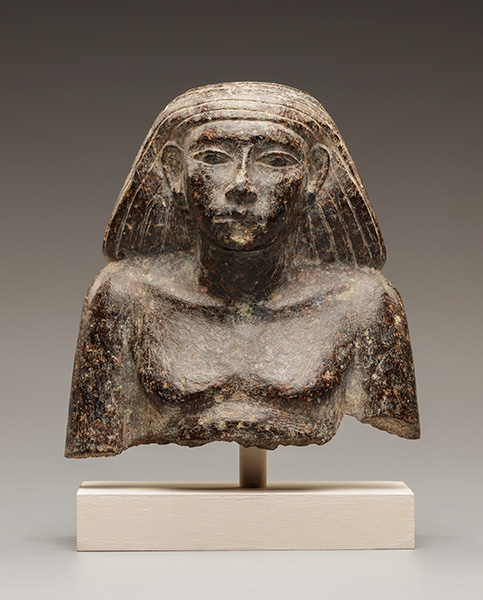
Seated statue of Kay, Middle Kingdom, Dynasty 12–13, ca. 1950–1640 BCE. Egypt, Memphite Region, Lisht South, tomb of Senwosretankh, debris, MMA excavations, 1932–33. Granodiorite, H. 24.5 cm. The Metropolitan Museum of Art, Rogers Fund, 1933 (33.1.3).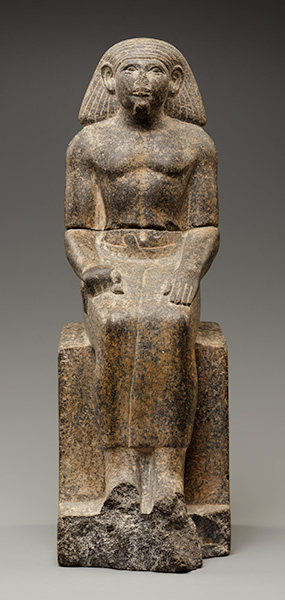
This difference is readily visible in examining two small sculptures, both excavated by The Metropolitan
Image captured from RTI of detail of wig from 15.3.579 (serpentinite) with specular enhancement. The red arrow indicates traces of rough polishing. Image captured by the author. 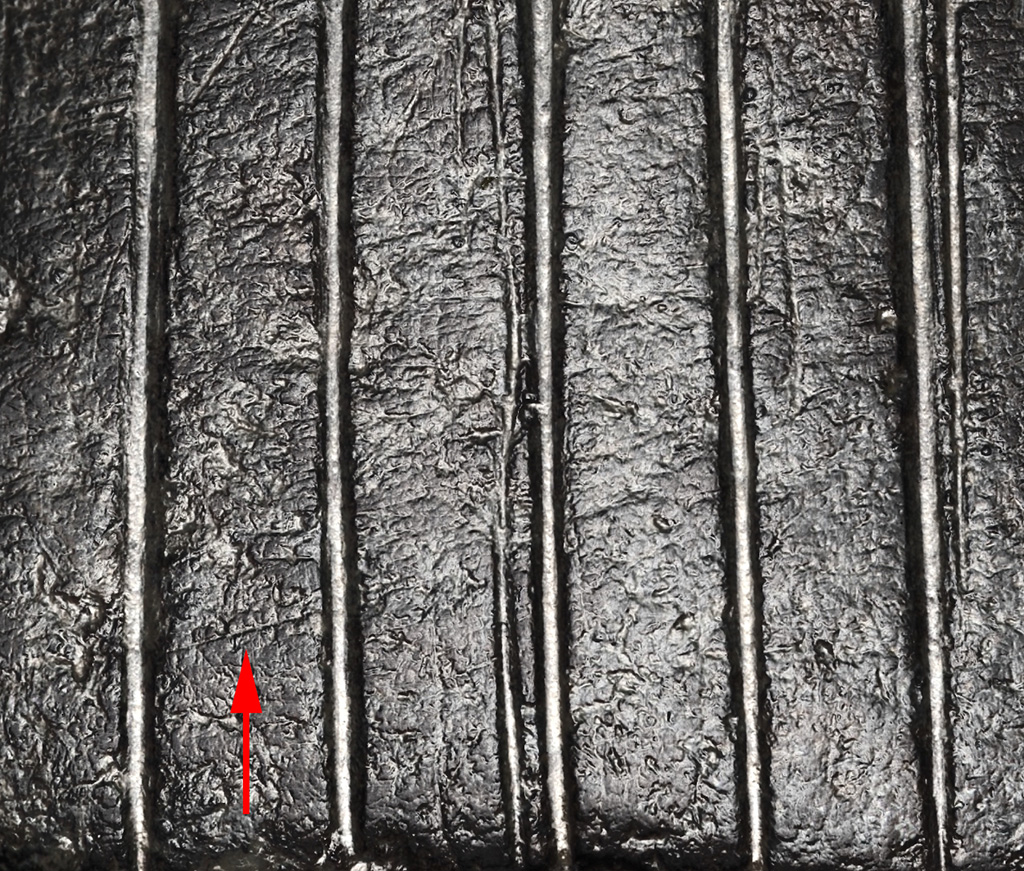
Image captured from RTI of detail of wig from 33.1.3 (granodiorite) with specular enhancement. The red arrow indicates tool slip. Image captured by the author.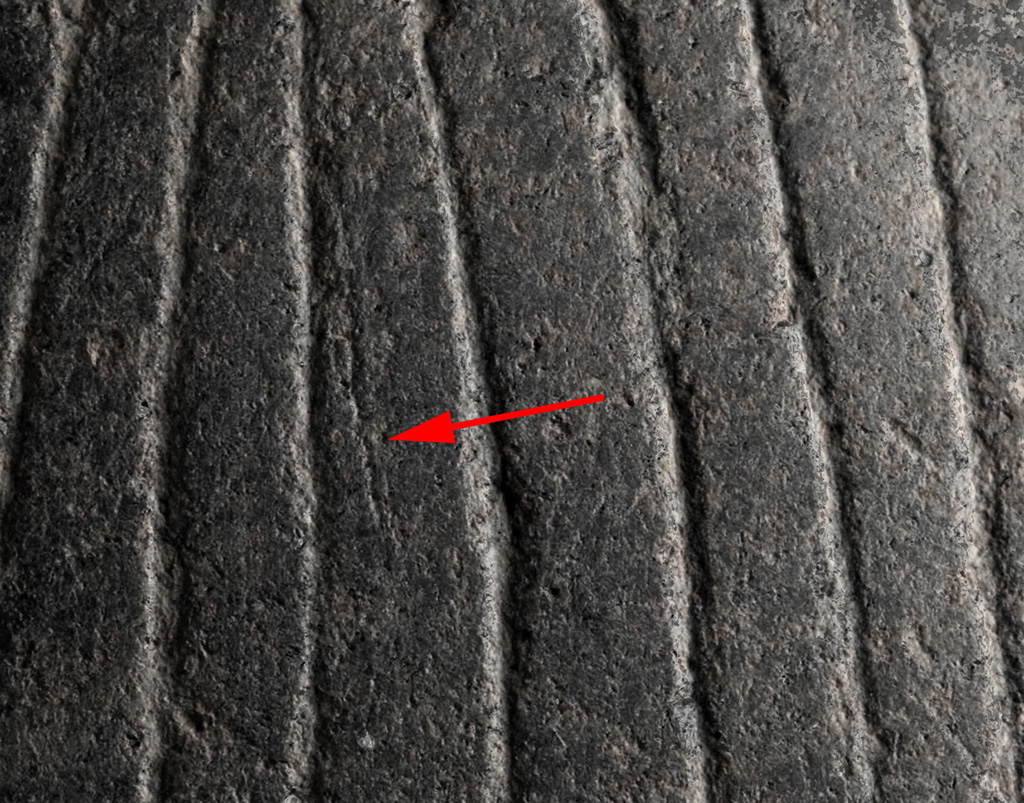
Examining details from the wigs of both statues (Figs. 5, 6), which are at roughly the same scale, one can see several distinct differences. First, the raised, flat surface of the serpentinite statue still bears rough scraping or abrasion that was likely one of the final steps in sculpting the wig. This was followed up by polishing with finer abrasives, but in this case the deeper cuts from the rough finishing step were not fully polished away and are still preserved.
Images from RTI of MFA 11.732 with specular enhancement (left) and coefficient unsharp masking (right). Anorthositic gneiss, 36 x 16 x 23.2 cm, Old Kingdom, Dynasty 4, reign of Menkaura 2490–2472 BCE, Menkaura Valley Temple, Harvard University – Boston Museum of Fine Arts Expedition. Images captured by the author. 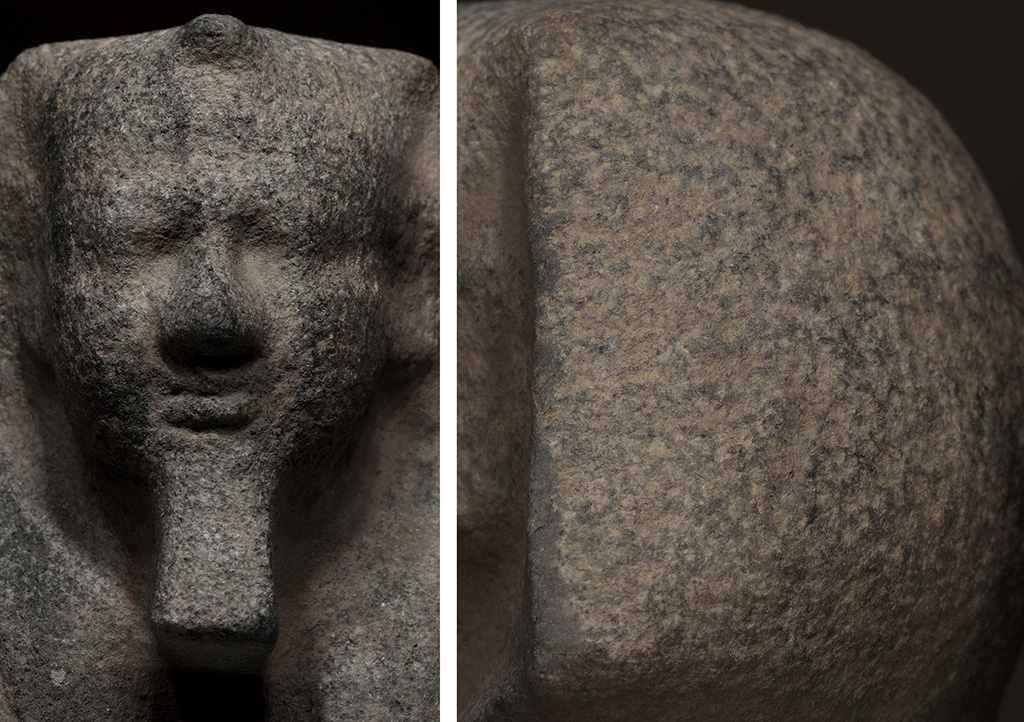
The hard stone, on the other hand, was probably shaped by pounding until it was very close to its final form. Stocks noted the characteristic pitted appearance of ancient hard stone artifacts;64 a remnant of this process can be seen on the an unfinished statuette of king Mycerinus from the Museum of Fine Arts, Boston (Fig. 7, MFA 11.732). In contrast, the seated statue of Kay (Figs. 4, 6, 33.1.3) appears to have been worked to completion, likely with progressively finer abrasives. The surface preserves very few signs of the abrasive process used to create the finished form because the hardness of the stone precludes deep scratches, and most of the shallow scratches are polished away. On both of these objects, and indeed on most Egyptian statuary I have examined, fine lines and other details were carved only after the finished forms were fully realized through rough and fine polishing. On the serpentinite object, a fine-tipped tool has been used to cut or scrape through the stone. The troughs of these lines are roughly v-shaped, but the v isn’t quite as sharp as it would be if created with a modern steel chisel. The width and depth of the line changes slightly, but not enough to indicate that the tip of the tool was constantly damaged by the carving process. Although tiny striations in the deeper lines indicate that they were likely done in more than one pass, the relatively deep “slip-ups” alongside two of the lines indicate that the stone can be deeply scraped with a single pass. On the other hand, the lines in the granodiorite, even though they are very finely done, clearly represent significantly more effort. These lines would have likely been done with a flint chisel, held at a very steep angle to the surface and utilizing percussive fractures at grain boundaries to remove stone. The width and depth of the lines vary quite a bit and there are fractures along the edges of the line troughs where grains dislodged during the percussive process. Slip-ups can often be observed on hard stone – for example, the slip along the second line from the left; but this too has an inconsistent depth and edge fractures. The sculptor of the granodiorite also seems to have had a more difficult time keeping the lines parallel.
Even if both statues were carved with flint tools, those tools would have been used very differently. And in the case of the serpentinite statue, bronze tools cannot be ruled out. These two images highlight not only varying tool kits and tool functions, but also differences in finishing technique.
Image from RTI of 37.6.1 with coefficient unsharp masking. Seated statue of King Menkaure, Old Kingdom, Dynasty 4, reign of Menkaure, ca. 2490–2472 BCE. Egypt, Memphite Region, Giza, Pyramid Complex of Menkaure, Valley Temple: Sculptor’s workshop, Harvard-Boston MFA excavations, 1911. Indurated limestone, H. 20 cm. The Metropolitan Museum of Art, Rogers Fund, 1937 (37.6.1). Image captured by the author.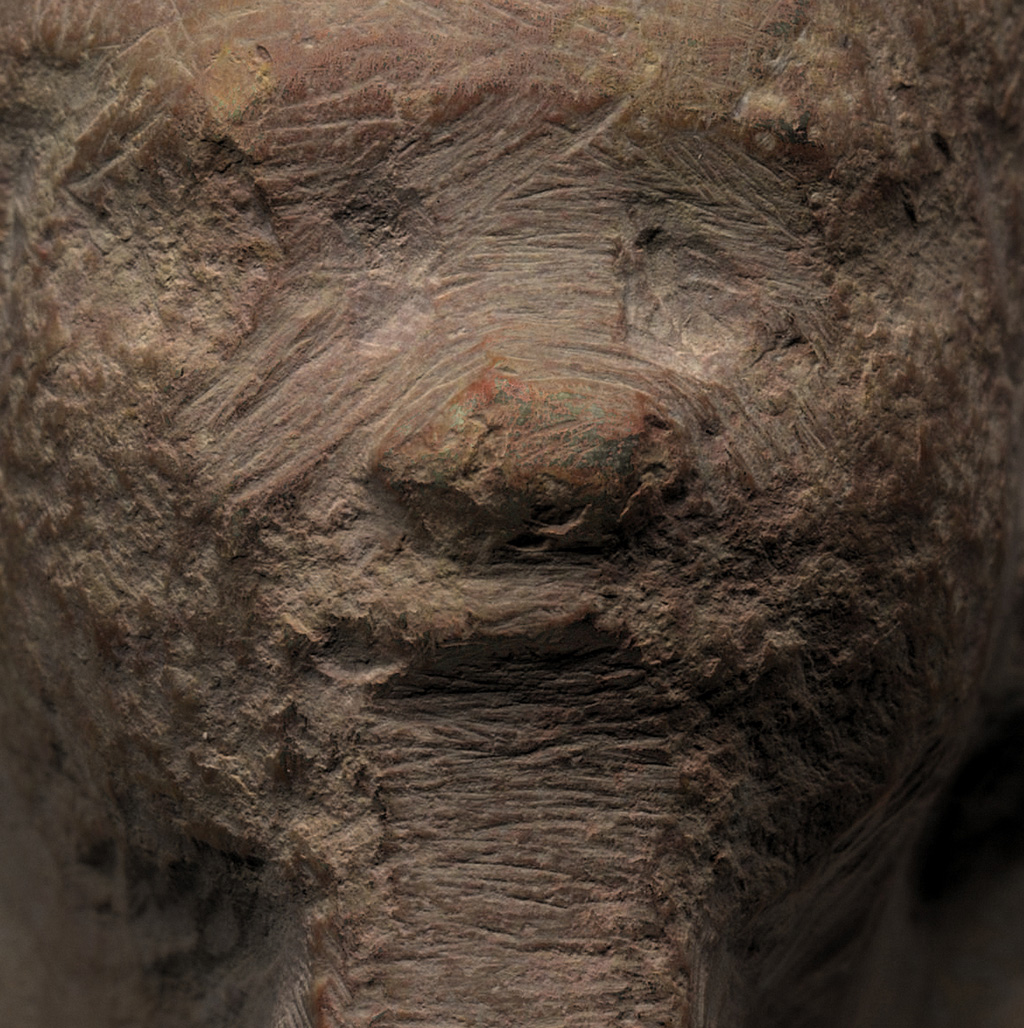
Interestingly, an indurated limestone unfinished seated statue of King Menkaure (Fig. 8, 37.6.1) exhibits traces of both hard and soft stone carving techniques. In a detail of the face one can see both the pitted appearance of an unfinished hard stone surface and the deeper scratch marks of the scraping action that was used to shape softer stones. This statue is carved from indurated limestone, which is harder than other limestones owing to more coarsely crystalline calcite or the presence of secondary dolomite or secondary quartz.65 Also worth noting is the link between tool form and use in the Old and Middle Kingdoms; although both unfinished statues of Menkaure
4.2 Variations in Hard Stone Technique: Finishing Work
It is clear that hard stone carving required specialized tools and methods, but even among hard stones there is significant variation in the carving process and its product. And as with the distinction between hard and soft stone methodology this difference is driven by the make-up of the stone itself. Consider the divergent finishing work evident in the examination of a group of sculpture fragments excavated at Amarna (Fig. 9).
a) Crown with disks, New Kingdom, Amarna Period, Dynasty 18, ca. 1353–1336 BCE. Egypt, Middle Egypt, Amarna (Akhetaten), Petrie/Carter excavations, 1891–92. Diorite, H. 11 cm. The Metropolitan Museum of Art, Gift of Edward S. Harkness, 1921 (21.9.5333). b) Body fragment with garment pleats, New Kingdom, Amarna Period, Dynasty 18, reign of Akhenaten, ca. 1353–1336 BCE. Egypt, Middle Egypt, Amarna (Akhetaten), Petrie/Carter excavations, 1891–92. Diorite, H. 10.5 cm. The Metropolitan Museum of Art, Gift of Edward S. Harkness, 1921 (21.9.536). c) Torso of king with hand of queen offering behind, New Kingdom, Amarna Period, Dynasty 18, ca. 1352–1336 BCE. Egypt, Middle Egypt, Amarna (Akhetaten), Petrie/Carter excavations, 1891–92. Silicified sandstone, H. 22 cm. The Metropolitan Museum of Art, Gift of Edward S. Harkness, 1921 (21.9.436). d) Mouth of Akhenaten or Nefertiti, New Kingdom, Amarna Period, Dynasty 18, reign of Akhenaten, ca. 1353–1336 BCE. Egypt, Middle Egypt, Amarna (Akhetaten, Petrie/Carter excavations, 1891–92. Silicified sandstone, H. 5.5 cm, W. 8 cm, D. 7 cm. The Metropolitan Museum of Art, Gift of Edward S. Harkness, 1921 (21.9.18).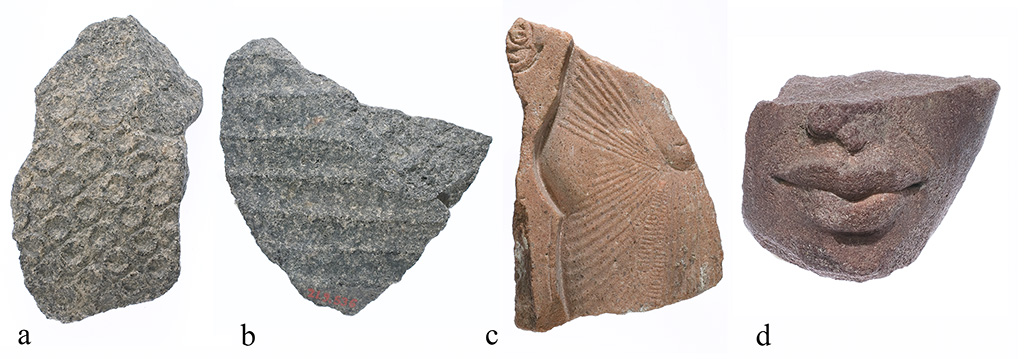
The crown with disks (Fig. 9a, 21.9.533) and body fragment with garment pleats (Fig. 9b, 21.9.536) are both carved from a dark hard stone which is identified as diorite.66 The torso of a king with the hand of a queen offering behind (Fig. 9c, 21.9.436) and the mouth of Akhenaten or Nefertiti (Fig. 9d, 21.9.18) are carved from stone commonly referred to in English as pink or red quartzite, but geologically it is
Detail from RTI of 21.9.533 (diorite) with specular enhancement. Image captured by the author.
Detail from RTI of 21.9.536 (diorite) with specular enhancement. Image captured by the author.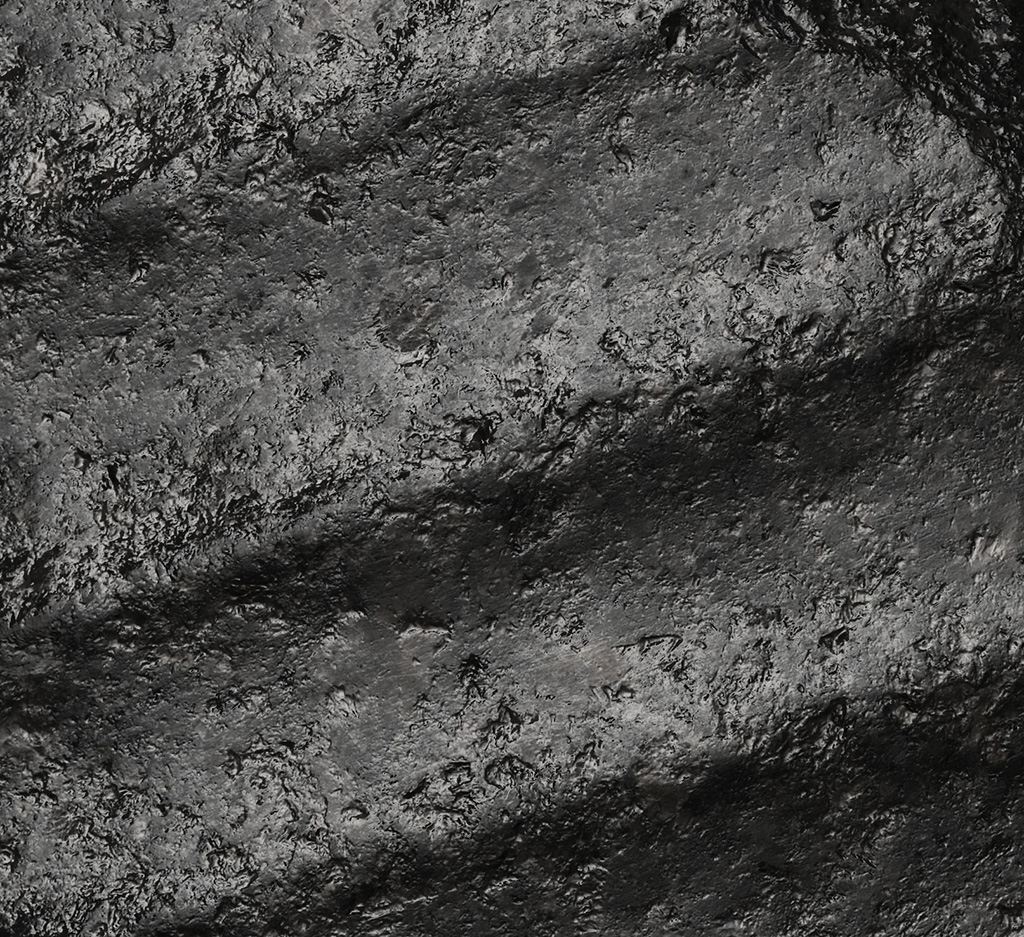
Variation in the chisel position is evident in the crown fragment (Fig. 10). Individual blows are evident in the lines around the circular elements, and the centers of the circles appear to have been carved with a few blows from varying angles. Though the sculptor seems to have used a system of squares to keep the circular elements relatively regular, overall the carving appears to have been executed with the aim of speed, rather than striving for perfect uniformity, and there is no evidence of the use of abrasives after the percussive work. The fragment of the garment, on the other hand, has little remaining evidence of percussive work (Fig. 11). Some pitting visible in the image may be traces of chisel blows, but such pitting also results from natural weathering. More importantly, this surface has been worked extensively with abrasives, minor traces of which can be seen running parallel to the ridges (Fig. 12). In both cases, it might be speculated that the sculptor was exploiting the textural differences that result from these divergent finishing methods. Another possibility is that the sculptor was unable to satisfactorily smooth the surface of the crown without losing definition, while smoothing the surface of the garment was a significantly simpler process.
Detail from RTI of 21.9.536 (diorite) with specular enhancement, showing traces of abrasive marks (indicated with red arrow). Image captured by the author.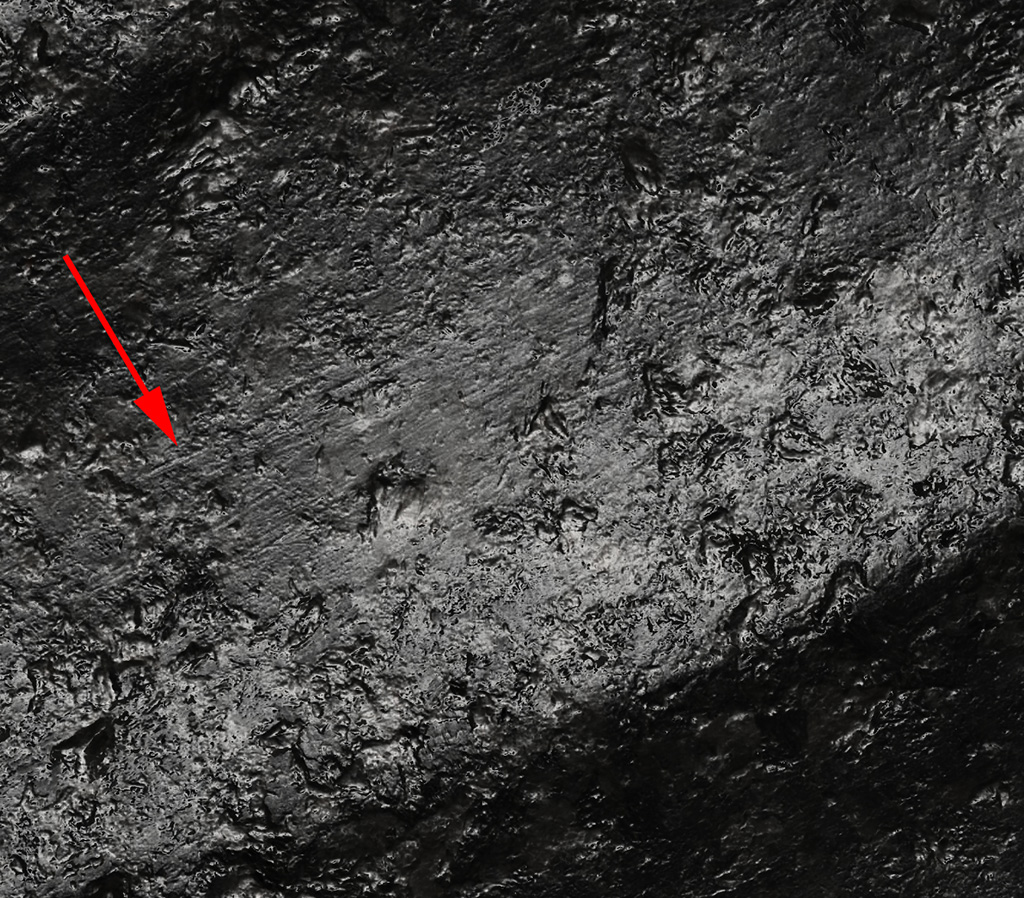
The silicified sandstone fragments exhibit several important differences in technique. As Aston et al.
Detail from RTI of 21.9.436 (silicified sandstone) with specular enhancement. Image captured by the author.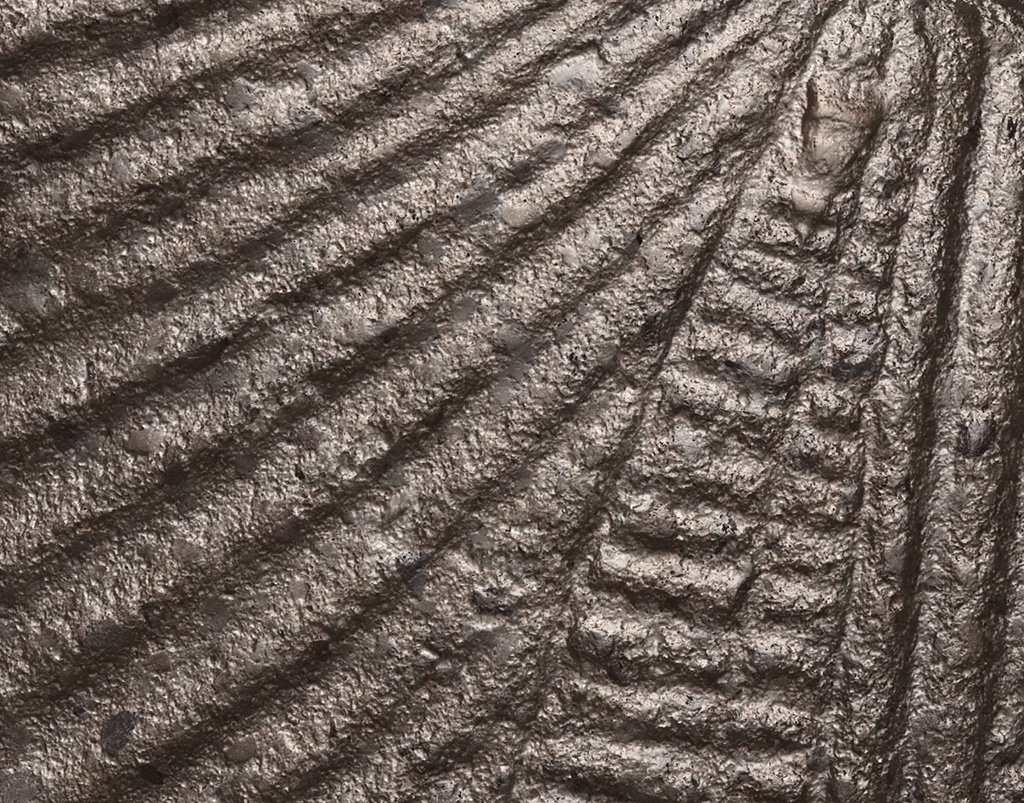
Detail from RTI of 21.9.18 (silicified sandstone) with specular enhancement. Image captured by the author. 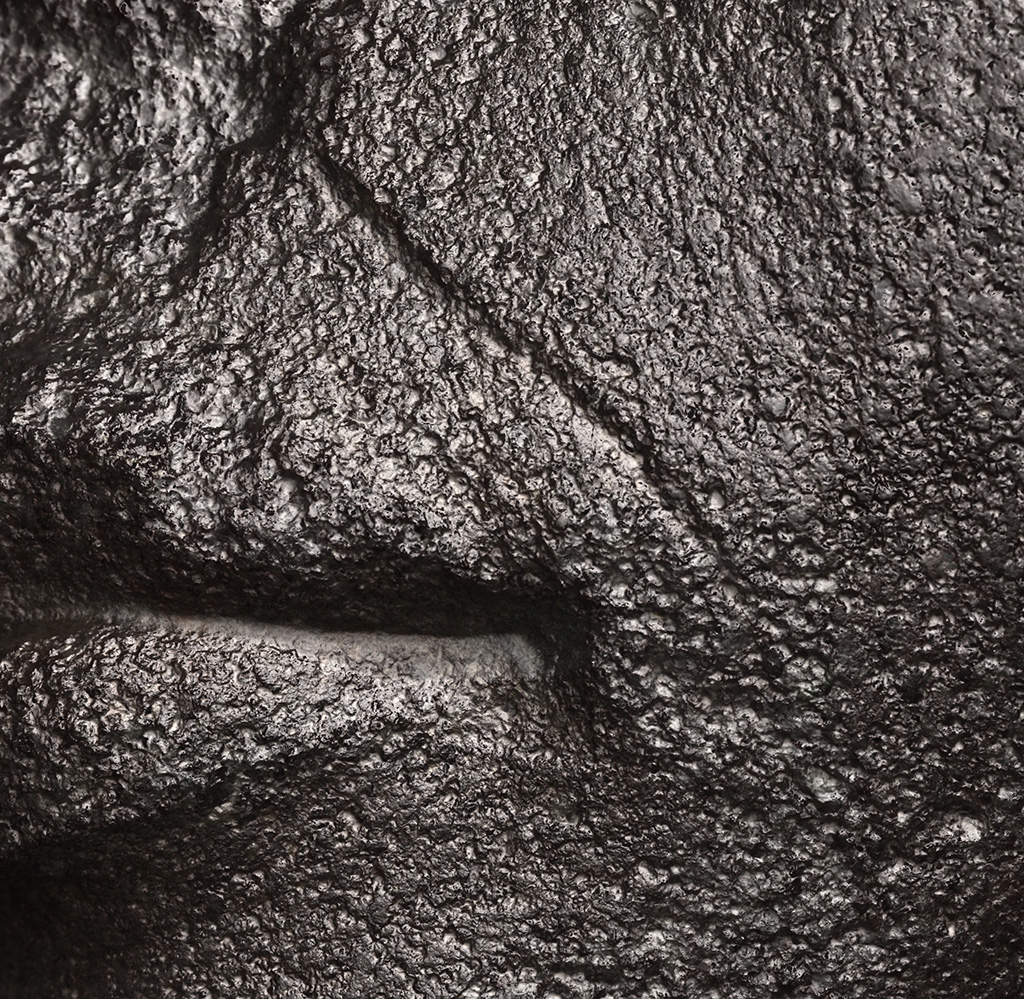
However, this less fluid approach does not necessarily imply greater precision. The carved pleats in the
The characteristic appearance of details in “quartzite” sculpture70 is almost certainly linked to the specialized method required to produce it. But while methodology is highly dependent on the properties of the stone and the available tools, it is also dependent on the skills and micro-decisions of the operator and other factors which could include financial resources, time constraints and aesthetic goals. Indeed, the rendering of fine details in hard stone varies rather significantly.
4.3 Variations in Hard Stone Technique: Inscriptions
This technical variation across stone types is also apparent when one examines the inscriptions added to sculpture. Take, for examples two 18th Dynasty sculpture fragments in The Met’s collection. One is a statue fragment, possibly of an upper right arm, with Aten cartouches (Fig. 15, 21.9.450) is carved from a dark hard stone previously catalogued as diorite. The other is the upper right chest of a queen wearing a pleated garment (Fig. 16, 57.180.52) which is carved from silicified sandstone.
Upper right arm with Aten cartouches, New Kingdom, Amarna Period, reign of Akhenaten, ca. 1353–1336 BCE. Egypt, Middle Egypt, Amarna (Akhetaten), Petrie/Carter excavations, 1891–92. Diorite, H. 11.9cm. The Metropolitan Museum of Art, Gift of Edward S. Harkness, 1921 (21.9.450).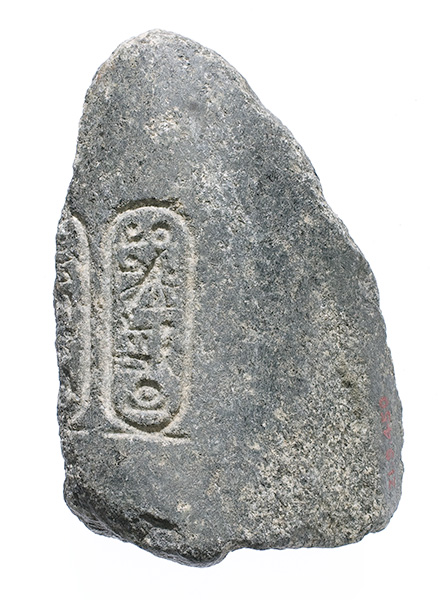
Upper right chest of a queen wearing a pleated garment and an elaborate broad collar, with cartouches of the Aten, New Kingdom, Amarna Period, Dynasty 18, reign of Akhenaten, ca. 1353–1336 BCE. Egypt, Middle Egypt, Amarna (Akhetaten), Great Temple of the Aten, pit outside southern wall, Petrie/Carter excavations, 1891–92. Silicified sandstone, H. 9.4 cm. The Metropolitan Museum of Art, Harris Brisbane Dick Fund, 1957 (57.180.52).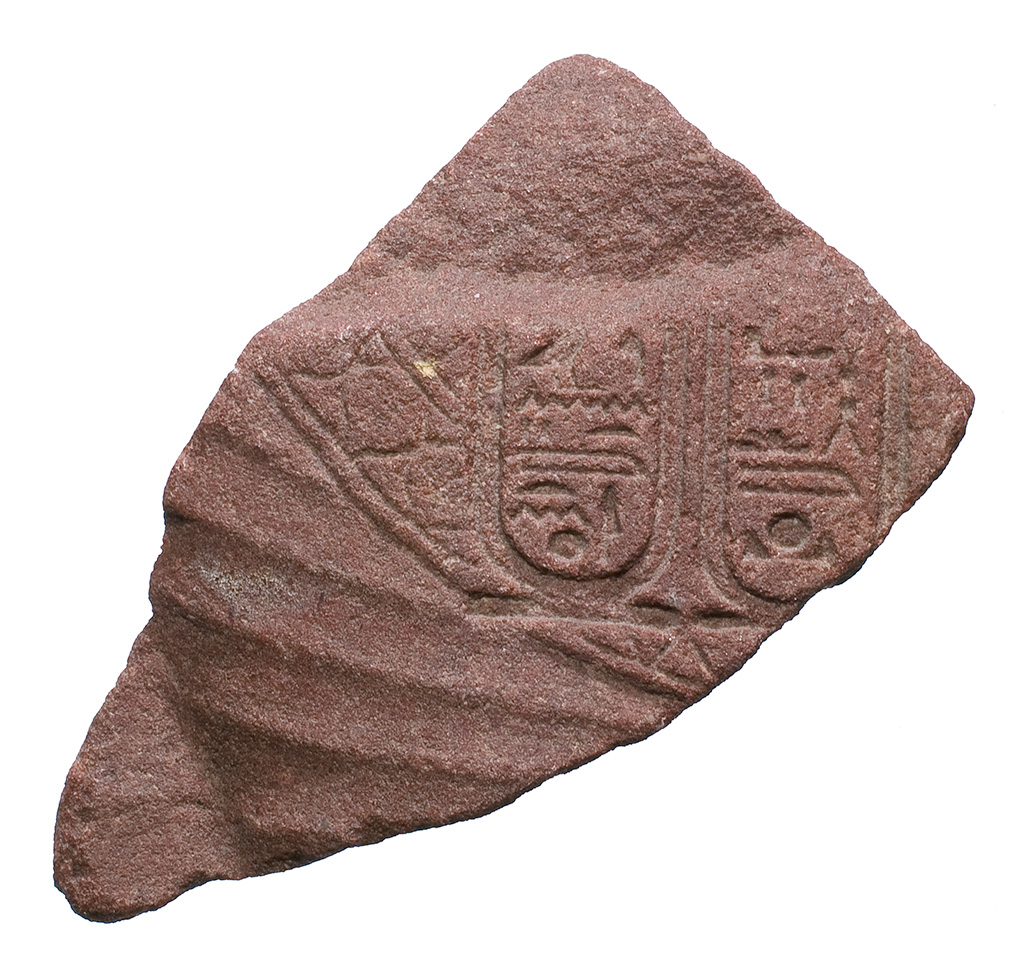
The inscription on the diorite fragment (Fig. 17) exhibits evidence for chisel angle variation discussed in the previous section, including micro-spalling along the edges of the lines and forms, and irregular pock-marks within the troughs, which indicate points of impact where the chisel was struck.
Images from RTI of 21.9.450 (diorite) with specular enhancement. Image captured by the author.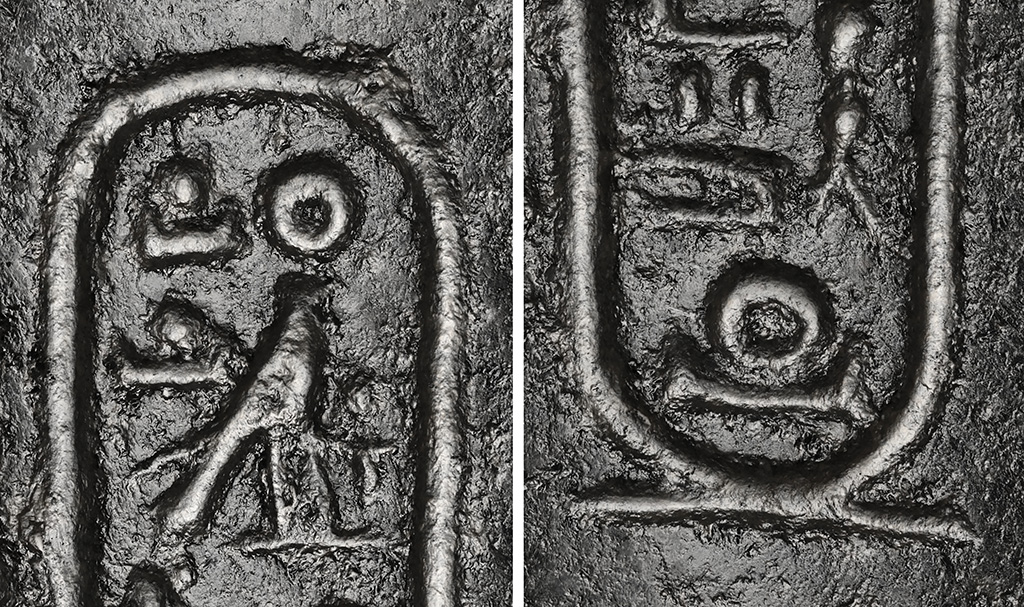
In the inscription on the silicified sandstone fragment shown in Fig. 18, on the other hand, it is clear
Images from RTI of 57.180.52 (silicified sandstone) with specular enhancement. Image captured by the author.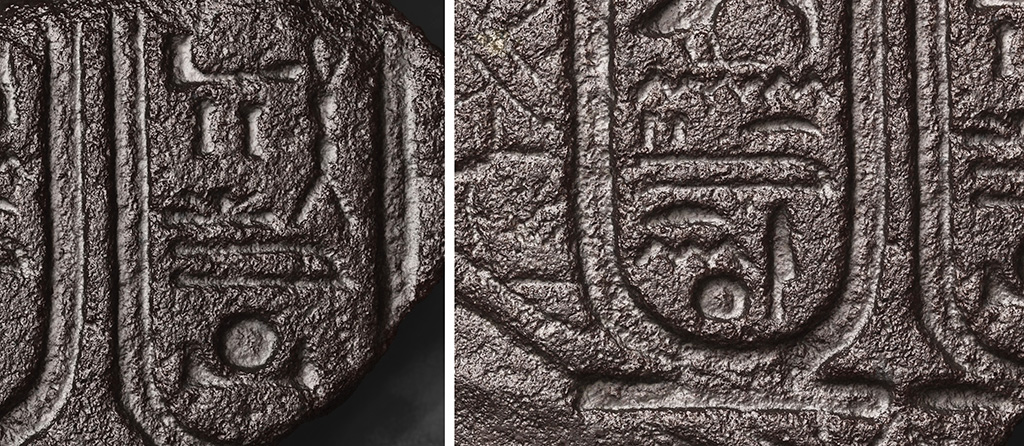
As with the finishing work previously described, the variations in inscription carving extend beyond differences in the working properties of a particular stone. The carving of hieroglyphs in granites, granodiorites and similar stones can range from rough lines and forms that appear more rapidly executed (Fig. 19a, 15.3.227, and Fig. 19c, 35.9.1) to highly precise renderings (Fig. 19b, 35.9.1, and Fig. 19d, 22.1.200). Interestingly, Fig. 19b, 19c are two details from the same object, illustrating that the handling of tools can vary over the surface of a single sculpture.71 Fig. 19d also exhibits another variation – lines which appear to have been scraped or polished after percussive carving. The economic impact of this added step on some sculpture is worth considering.
Images from RTIs of the following objects, with specular enhancement. a) Block statue of Minhotep, Middle Kingdom, late Dynasty 12 – early Dynasty 13, ca. 1850–1640 BCE. gypt, Memphite Region, Lisht North, cemetery south of pyramid below House A2:2, Pit 495, MMA excavations, 1913–14. Diorite, H: 17.5 cm. The Metropolitan Museum of Art, Rogers Fund, 1915 (15.3.227); b) and c) Block statue of the scribe of divine offerings, Tjaenwaset, son of Harsiese, Late Period, Kushite-Saite, Dynasty 25–26, ca. 690–610 BCE. Upper Egypt, Thebes, Karnak, Temple of Amun, Cachette. Dolerite, H: 25 cm. The Metropolitan Museum of Art, Gift of Edward S. Harkness, 1935 (35.9.1); d) The Chief of Police, Mentuhotep, Middle Kingdom, Dynasty 12, reign of Amenemhat I – Senwosret I, ca. 1981–1917 BCE. Egypt, Memphite Region, Lisht North, cemetery south of pyramid south of House A1:4, Pit 898, MMA excavations, 1920–21. Granodiorite, H: 45.9 cm. The Metropolitan Museum of Art, Rogers Fund and Edward S. Harkness Gift, 1922 (22.1.200). Images captured by the author.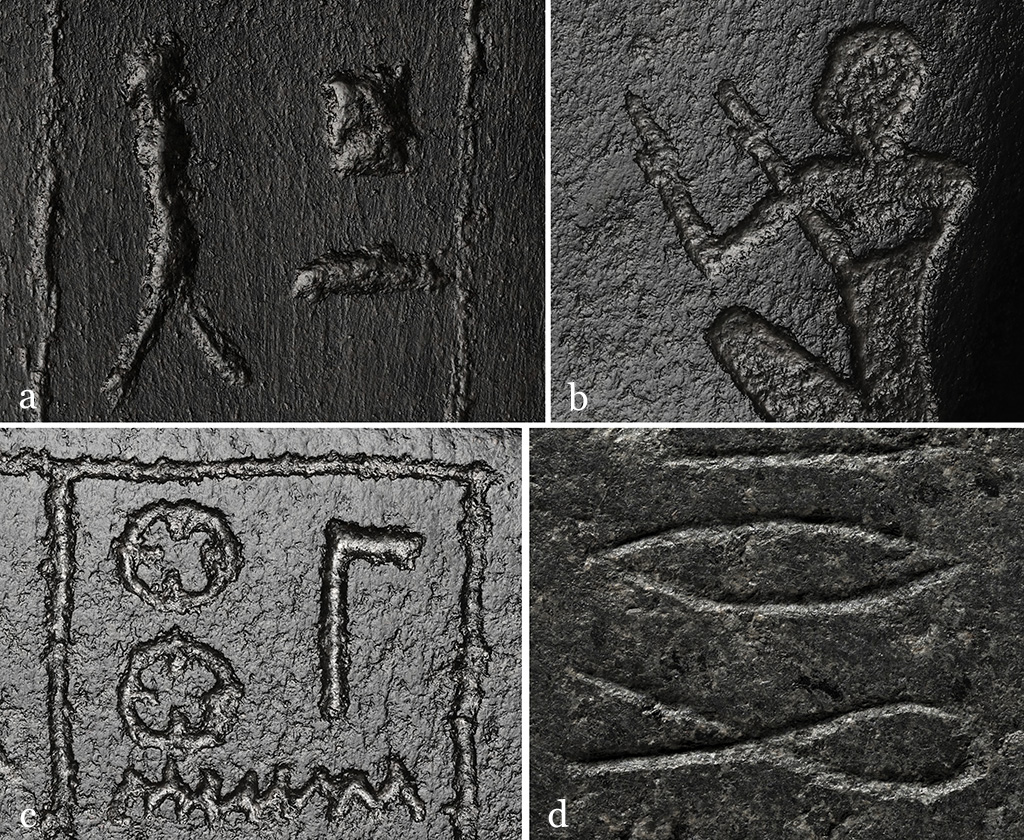
This group of images demonstrates that the close examination of individual tool marks can help help us better understand the manner of a sculpture’s production, and its implications.
It is also important to note where our current understanding of tools and methods cannot explain the marks visible on a surface. Still mysterious are the incredible fine, relatively deep details carved into hard stone sculpture such as a statuette of Khentykhety from the Museo Barracco in Rome (Fig. 20).72 This small, exquisitely carved statue from the Middle Kingdom has hieroglyphs and other fine details that are incredibly small and highly precise. Clearly they were executed with a percussive tool, but that tool would require an extremely hard and extremely fine point. Can flint knapped to such a fine point hold its shape beyond a single blow? What other materials could have been used to make these marks?
Statuette of Khenti-Kheti, Middle Kingdom, ca. 1987–1640. Upper Egypt, Abydos. Granodiorite, 29.7 cm. Museo Barracco, INV.MB11. Images captured by the author. Note that individual hieroglyphys visible in image on the right are approximately 1–2 cm in height and lines are only about a millimeter wide, at most. 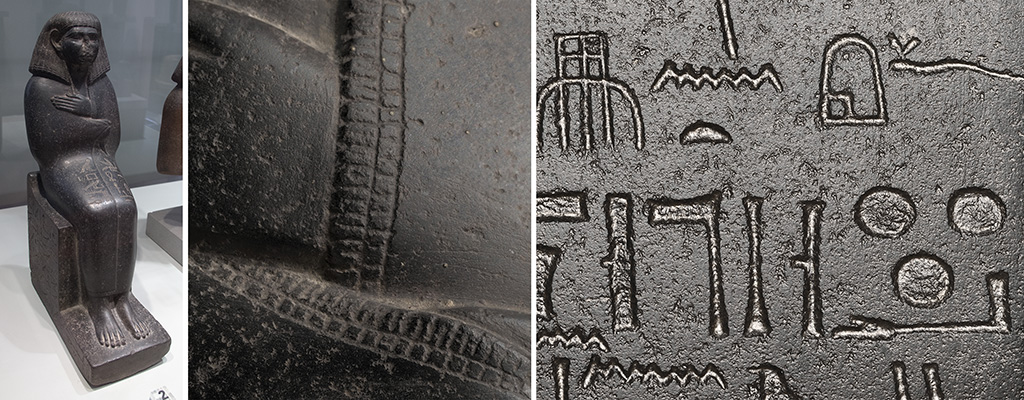
This section and the previous one have focused predominantly on small details, but it is equally critical to pull back and understand the relationship between marks across a surface, and note trends in the directionality of tool marks and the degree to which the object is “finished”. Regarding the latter point, Kozloff et al. note that “the contribution of the polished surface to the completed statue is, for those in hard stone, an index of the monument’s status—and generally of its aesthetic merit.”73 Mapping these observations
In general, the similarities and differences between the tool marks on the sculptures presented here, and on others examined in the course of this study, may be attributable to numerous factors: degree of finish, skill of the craftsperson (or craftspeople), workshop traditions, desired aesthetic effect, time-investment, the dimensions of the sculpture, the context for which it was made, and so forth. We must also recognize that methodology and desired aesthetic shifted over time, and that our understanding of the marks on a sculpture’s surface must be informed by its state of preservation and any subsequent modifications. Determining the relative significance of these similarities and differences relies on broad visual comparison.
4.4 Evidence of a Changing Tool Kit
Wootton, Russell and Rockwell note that stone carving is generally a conservative craft,74 and while this is certainly true for Egypt, over the approximately 4000 years of history that spanned the Predynastic through the Greco-Roman Periods there were some important changes in tool kit and methodology that were driven both by technological advances and by changing requirements for tools. One such shift, already mentioned, is the adoption of iron tools for stone carving. Sheila Adam argued convincingly that Greek stone carvers used iron tools on marble,75 but at what point does the shift away from flint tools for hard stone carving occur? Can we see evidence for this shift, and how different are the marks made by these tools?
Block statue of the scribe of divine offerings, Tjaenwaset, son of Harsiese, Late Period, Kushite-Saite, Dynasty 25–26, ca. 690–610 BCE. Egypt, Upper Egypt, Thebes, Karnak, Temple of Amun, Cachette. Dolerite, H. 25 cm. The Metropolitan Museum of Art, Gift of Edward S. Harkness, 1935 (35.9.1).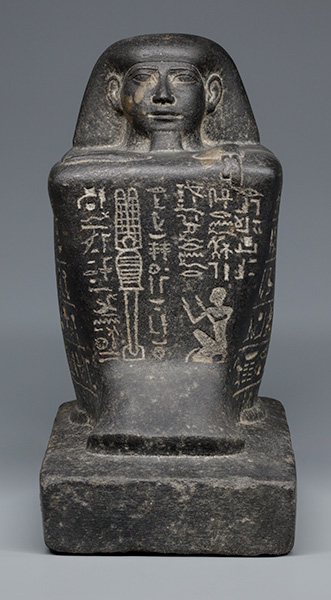
Statue of the priest Harnefer, son of Nesmin and of Nehemesrattawy, Ptolemaic Period, late 4th century BCE. Egypt, Upper Egypt, Thebes, Karnak, Temple of Amun, Cachette. Diorite, H. 59.2 cm. The Metropolitan Museum of Art, Mr. and Mrs. Isaac D. Fletcher Collection, Bequest of Isaac D. Fletcher, 1917 (MMA 17.120.145).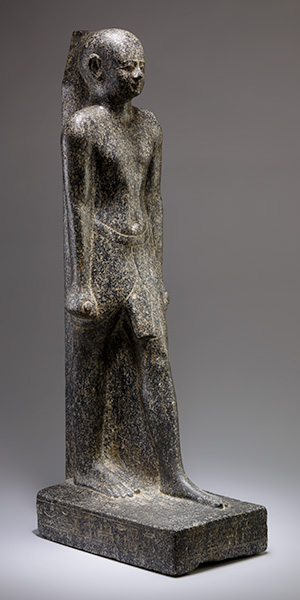
A useful comparison can be found in examining the tools marks remaining on two statues from the 4th century BCE and comparing these with the marks on
Images from RTIs of 35.9.1 (dolerite) with specular enhancement. Images captured by the author.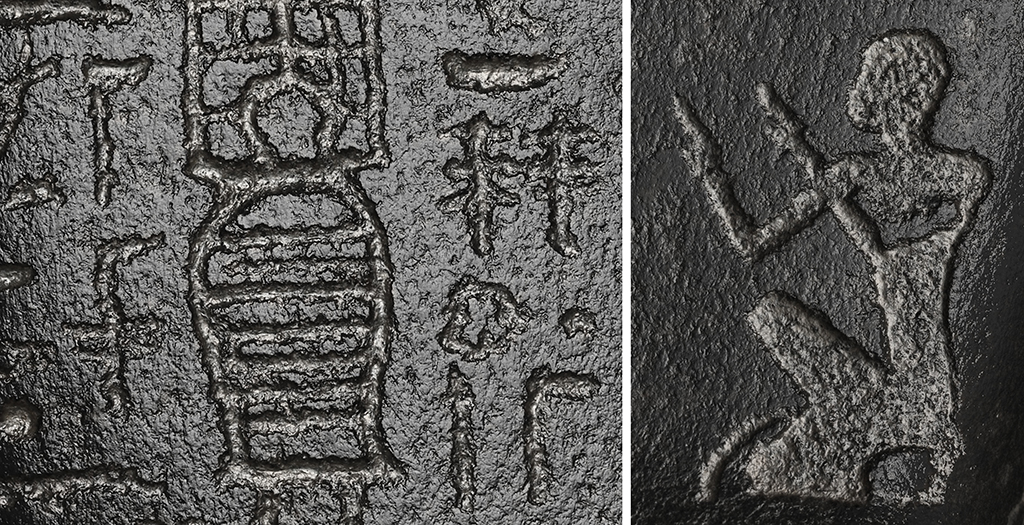
Some subtle but critical differences are evident a statue of the priest Harnefer (Fig. 22, 17.120.145) which dates to the late 4th century BCE. Deep chisel marks appear to have been made relatively rapidly in the carving of the lines of the kilt (Fig. 24a) as well as of the hieroglyphs (Figs. 24b, 24c). The sides of some of the troughs appear very steep, almost perpendicular to the sculpture’s surface. Similar marks can be seen in the hieroglyphs carved on another 4th century hard stone sculpture, a head from a statue with magical texts (Fig. 25, 1989.281.102). Although such steep trough angles are found in earlier sculpture, they seem to have required repeated percussion or abrasion to achieve. Therefore, the seemingly
Also interesting to note are the abrasive marks running diagonally across the hieroglyphs in Fig. 24c and vertically along the break edge in Fig. 25c. These marks are different in character from earlier abrasive marks – they are relatively deep, highly parallel and very long. Perhaps this is evidence for the use of an iron scraper or a similar tool employed by Roman stone workers.78
Images from RTIs of 17.120.145 (diorite) with specular enhancement. Images captured by the author. The red arrow in (c) indicates diagonally running abrasive marks. 
Images from RTIs of 1989.281.102 (basalt) with coefficient unsharp masking. The red arrow in (b) indicates vertical abrasive marks along break edge. Images captured by the author.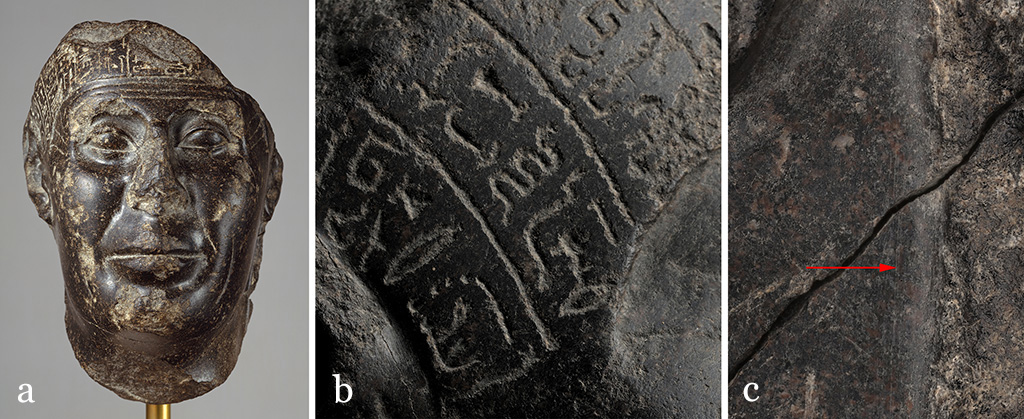
Image of RTI of hieroglyphs carved by the author using a steel chisel in Aswan granite, with specular enhancement.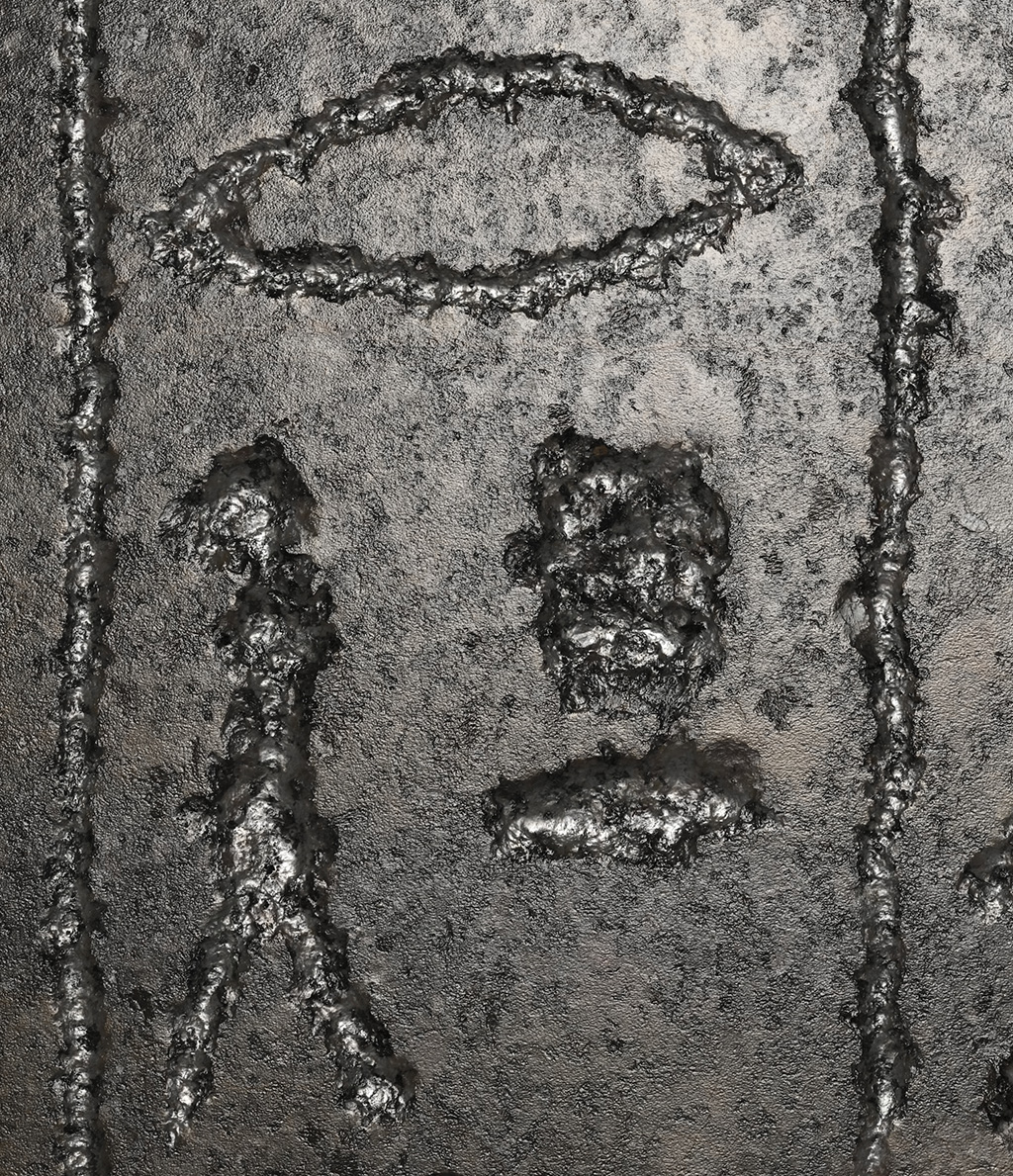
Images of RTIs of (a) hieroglyphs on the sarcophagus of Mindjedef (54.80). b) Hieroglyphs copied by the author using an experimentally produced flint chisel and c) a steel chisel. All substrates are Aswan granite. All images have specular enhancement applied.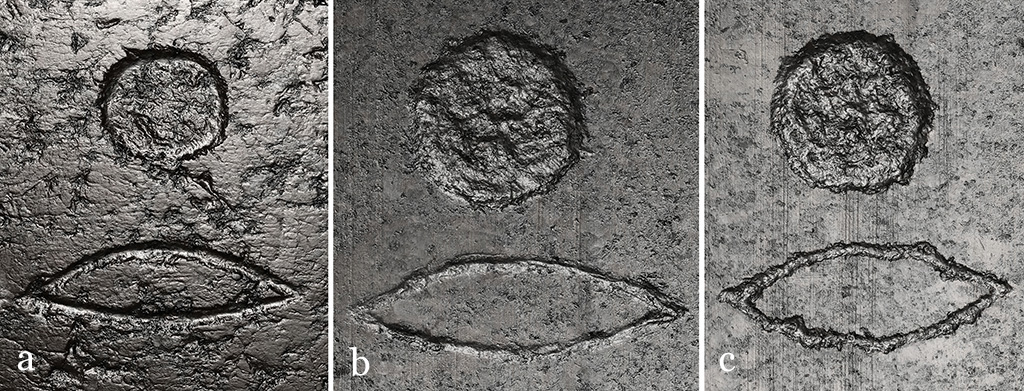
Returning to the question of chisel material, it is notable that experiments I conducted with a modern steel chisel on Aswan granite produced similar marks (Figs. 26, 27c) to those seen on the 4th century BCE statues. As previously discussed, replication experiments cannot stand alone as evidence for (or against) the use specific tools or techniques, especially when the work is carried out by a practitioner who is not a trained and practicing sculptor. But imperfect as my experiments are, the distinct differences in the marks made by flint and steel (Figs. 27b, 27c respectively) do suggest that such tools would produce different results. And although the steel chisel I used is decidedly different from its ancient iron predecessor, this experimental evidence suggests that the subtle differences noted in this section could well be linked to changes in the tool kit.
Did the Egyptians replace their flint chisels with iron chisels, and if so, when? Iron was used in Greece by 1000 BCE and tempering – which would produce iron tools that were tough without being brittle – was known by the 8th century BCE.79 Given what is known about the movement of materials and craftspeople around the Mediterranean and Near East in the first millennium BCE, it is theoretically possible
5. Conclusion
As this article has demonstrated, documentation with RTI allows for a more detailed comparison of tool marks on a wide variety of stone types and a more accurate recording of complex surfaces. RTI documentation brings to light a wide variety of tool marks, many of which can reasonably be assigned to tools in the ancient stoneworker’s tool kit. However, this systematic recording of tool marks also generates a number of new questions, and there are still some tool marks that cannot yet be explained by existing scholarship. For example, could flint chisels really be used to produce the incredibly fine and relatively deep hieroglyphs on the seated Middle Kingdom statue from Museo Barracco? Are there, as Stocks suggests, tools that are completely missing from the archaeological record? Perhaps there are flint nodules that are especially tough and which could be knapped in a particular fashion so that they held a very fine point. Or perhaps chisels with incredibly fine points could be fashioned from dolerite or a similarly dense stone. Maybe points made from hard minerals like corundum, microcrystalline varieties of quartz or other gemstones could be embedded in another material like copper or wood and used as a graver. All of these hypotheses require further investigation, including the consideration of contemporary gemstone carving technologies around the region.82
Given the challenges to interpretation already mentioned, the images and observations presented in this article should serve not as definitive examples of a particular tool or technique, but rather as a starting point for useful comparison. Despite the seemingly programmatic approach to sculpture production, Egyptian stone statuary exhibits tremendous technical variation at the micro level. This makes sense – the ancient world had craftspeople with skill levels that were miraculous, mediocre, and everything in between. Tools must also have varied in quality
A better understanding of all of this variation would be greatly aided by further exploration of the relationship between tool marks over the entire surface of an object. This is, of course, part of standard visual examination, but really understanding the relationship of toolmarks across a sculpture’s surface may benefit from from technology beyond RTI. The creation between high-resolution 3-D models could facilitate the recording and scholarly exploration of tool marks across a surface while also providing actual geometric data, such as the specific angle and depth of a mark. This technology is rapidly advancing, and I plan to explore its possibilities in future work.
Another useful avenue to explore would involve looking beyond the borders of Egypt. What can we learn by exploring other ancient stone carving traditions? Sculptors of hard stone in the ancient Near East, South America, Asia and elsewhere faced similar challenges to their Egyptian counterparts. Cross-cultural comparison of tool marks might shed some additional light on questions such as the distinction between abrasive marks made by quartz and harder minerals, or the distinction between marks made from stone and iron chisels.
And lastly, in the realm of authenticity studies, it will be necessary to thoroughly understand the carving technology employed in the creation of forgeries. Documenting tool marks on known forgeries would provide another critical point of comparison.
This study leaves many questions unanswered and raises many new questions that are equally challenging to address. However, it is clear that learning to read the marks inscribed in a surface helps us to tell the production story of an object. Even if there are gaps in the story, the actions illuminated by the study and documentation of tool marks may give significant insight into the context of a sculpture’s production. Tool marks can help us better understand aesthetics and style, and they can also hint at energy expenditure and the resources required for sculpture production. Lastly, tool marks have an immediacy. They can give us access to the individuals who created an object, including their handling of tools, micro-mistakes and decision-making – sometimes this is the closest we can get to these often extraordinarily skilled individuals who were rarely memorialized.
Bibliography
Adam, Sheila, The Techniques of Greek Sculpture, Athens 1966.
Arnold, Dieter, Building in Egypt: Pharaonic Stone Masonry, New York 1991.
Arnold, Dorothea, “The Workshop of the Sculptor Thutmose”, in Dorothea Arnold (ed.), The Royal Women of Amarna: Images of Beauty in Ancient Egypt, New York 1996, pp. 41–84.
Aston, Barbara G., James A. Harrell, and Ian Shaw, “Stone”, in: Paul T. Nicholson and Ian Shaw (eds.), Ancient Egyptian Materials and Technology, Cambridge 2000, pp. 5–77.
Blackwell, Nicholas G, “Making the Lion Gate Relief at Mycenae: Tool Marks and Foreign Influence”, AJA 118/3 ( July 2014).
Carò, Federico and Anna Serotta, “Evidence for the Use of Corundum Abrasive in Egypt from the Great Aten Temple at Amarna”, Horizon 14 (Spring 2014), pp. 2–4.
Connor, Simon, “Sculpture Workshops: Who, Where and for Whom?” in: Gianluca Miniaci, Juan Carlos Moreno Garcia, Stephen Quirke, and Andréas Stauder (eds.), The Arts of Making in Ancient Egypt: Voices, Images and Objects of Material Producers 2000-1500 BC, Leiden 2018, pp. 11–30.
Connor, Simon, Être et paraître: statues royales et privées de la fin du Moyen Empire et de la Deuxième Période intermédiaire (1850-1550 a. J.-C.) (Middle Kingdom Studies 10), London 2020.
Craddock, Paul T., Scientific Investigation of Copies, Fakes and Forgeries, Oxford 2009.
De Putter, Thierry and Christina Karlshausen, Les pierres utilisées dans la sculpture et l’architecture de l’Egypte Pharaonique: guide pratique illustré (Connaissance de l’Égypte ancienne 4), Bruxelles 1992.
De Putter, Thierry and Christina Karlshausen, Pierres de l’Égypte ancienne: guide des matériaux de l’architecture, de la sculpture et de la joaillerie (Connaissance de l’Égypte ancienne 20), Bruxelles 2022.
Dehejia, Vidya and Peter Rockwell, The Unfinished: The Stone Carvers at Work in the Indian Subcontinent, New Delhi 2016.
Devaux, Judith, “Nature du métal employé pour les outils des sculpteurs égyptiens”, RdE 50 (1999), pp. 275–77.
Devaux, Judith, “Définition de quelques caractéristiques techniques de la statuaire de pierre dure en Égypte ancienne”, RdE 51 (2000), pp. 39–53.
Earl, Graeme, Kirk Martinez, and Tom Malzbender, “Archaeological Applications of Polynomial Texture Mapping: Analysis, Conservation and Representation”, JAS 37/ 8 (2010), pp. 2040–50.
Gagarin, Michael and Elaine Fantham, The Oxford Encyclopedia of Ancient Greece and Rome, New York, 2010.
Gorelick, Leonard and A. John Gwinnett, “Ancient Egyptian Stone-Drilling: An Experimental Perspective on a Scholarly Disagreement”, Expedition 25/3 (1983), pp. 40–47.
Gorelick, Leonard and A. John Gwinnett, “Minoan Versus Mesopotamian Seals: Comparative Methods of Manufacture”, Iraq 54 (1992), pp. 57–64.
Gwinnett, A. John and Leonard Gorelick, “Ancient Lapidary: A Study Using Scanning Electron Microscopy and Functional Analysis”, Expedition 22 (1979), pp. 17–32.
Gwinnett, A. John and Leonard Gorelick, “Beads, Scarabs, and Amulets: Methods of Manufacture in Ancient Egypt”, JARCE 30 (1993), pp. 125–32.
Harrell, James A., “Gemstones”, in: Willeke Wendrich (ed.), UCLA Encyclopedia of Egyptology, Los Angeles 2012, https://escholarship.org/uc/item/57f2d2sk
Harrell, James A, “Building Stones”, in: Willeke Wendrich (ed.), UCLA Encyclopedia of Egyptology, Los Angeles 2012, https://escholarship.org/content/qt3fd124g0/qt3fd124g0.pdf
Harrell, James A., V. Max Brown, and Masoud Salah Masoud, Survey of Ancient Egyptian Quarries, Cairo 1996.
Heimpel, Wolfgang, Leonard Gorelick, and A. John Gwinnett, “Philological and Archaeological Evidence for the Use of Emery in the Bronze Age Near East”, Journal of Cuneiform Studies 40/2, 1988, pp. 195–210.
Heldal, Tom, Elizabeth Bloxam, Per Stormyr and Adel Kelany, “Geology and Archaeology of the Ancient Silicified Sandstone Quarries at Gebel Gulab and Gebel Tingar, Aswan, Egypt”, Marmora: International Journal for Archaeology History and Archaeometry of Marbles and Stone 1 (2005), pp. 11–35.
Hirt, Alfred Michael, Imperial Mines and Quarries in the Roman World: Organizational Aspects, 27 BC–AD 235, Oxford 2010.
Klemm, Rosemarie and Dietrich D. Klemm, Stones and Quarries in Ancient Egypt, London 2008.
Köhler, E. Christiana, Elizabeth Hart, and Michael Klaunzer. “Wadi El-Sheikh: A New Archaeological Investigation of Ancient Egyptian Chert Mines”, PLOS ONE 12/2 (2017).
Kozloff, Arielle P., Betsy Morrell Bryan, Lawrence Michael Berman, and Elisabeth Delange, Egypt’s Dazzling Sun: Amenhotep III and His World, Cleveland 1992.
Lazzarini, Lorenzo, “I vasi in pietra minoici di Festòs: primi dati sulla natura e provenienza dei materiali lapidei”, Atti dei convegni Lincei: i cento anni dello scavo di Festòs, Rome 2001, pp. 575–96.
Lucas, Alfred and John Richard Harris, Ancient Egyptian Materials and Industries, London 1962.
Mudge, Mark, Jean-Pierre Voutaz, Carla Schroer, and Marlin Lum, “Reflectance Transformation Imaging and Virtual Representations of Coins from the Hospice of the Grand St. Bernard”, in: Mark Mudge, Nick Ryan, and Roberto Scopigno (eds.) VAST 2005: The 6th International Symposium on Virtual Reality, Archaeology and Intelligent Cultural Heritage, Incorporating 3rd Eurographics Workshop on Graphics and Cultural Heritage: ISTI-CNR Pisa, Italy, November 8–11, 2005, pp. 29–39.
Nour, Mohammed Zaki, Zaki Iskander, Mohammed Salaḥ Osman, and Aḥmad Youssof Moustafa, The Cheops Boats. Part I, Cairo 1960.
Petrie, W.M. Flinders, Kahun, Gurob, and Hawara, London 1890.
Petrie, W.M. Flinders, Illahun, Kahun and Gurob: 1889–90, London 1891.
Petrie, W.M. Flinders, The Arts and Crafts of Ancient Egypt, Edinburgh 1909.
Petrie, W.M. Flinders, Tools and Weapons (BSAE 22), London 1917.
Phillips, Jacke, “How to Build a Body Without One: Composite Statues from Amarna” in: Janine Bourriau, Jacke Phillips, and Jacqueline S. Phillips (eds.), Invention and Innovation: The Social Context of Technological Change 2: Egypt, the Aegean and the Near East, 1650-1150 B.C. Proceedings of a Conference Held at the McDonald Institute for Archaeological Research, Cambridge, 4-6 September 2002, Oxford 2012, pp. 200–14.
Roehrig, Catharine H. and Anna Serotta, “The Stela of King Raneb”, in: Diana Craig Patch (ed.), Dawn of Egyptian Art, 2012, pp. 210–11.
Rockwell, Peter, The Art of Stoneworking, Cambridge 1993.
Rockwell, Peter, The Compleat Marble Sleuth, Sunny Isles Beach, FL 2004.
Russell, Ben and Will Wootton, “Makers and Making: Classical Art in Action”, in: Achim Lichtenberger and Rubina Raja (eds.), The Diversity of Classical Archaeology, Brepols 2017, pp. 253–70.
Sax, Margaret and Nigel D. Meeks, “Methods of Engraving Mesopotamian Quartz Cylinder Seals”, Archaeometry 37/1 (1995), pp. 25–36.
Serotta, Anna, “An Investigation of Tool Marks on Ancient Egyptian Hard Stone Sculpture: Short Note”, Metropolitan Museum Studies in Art, Science, and Technology 2 (2014), pp. 197–201 .
Sist, Loredana, Museo Barracco: Arte Egizia, Roma 1996.
Stocks, Denys A., “Tools of the Ancient Craftsman”, Popular Archaeology 7/6 (1986), pp. 25–29.
Stocks, Denys A, “Stone Sarcophagus Manufacture in Ancient Egypt”, Antiquity 73/282 (1999), pp. 918–22.
Stocks, Denys A., “Testing Ancient Egyptian Granite-Working Methods in Aswan, Upper Egypt”, Antiquity 75/287 (2001), pp. 89–94.
Stocks, Denys A., Experiments in Egyptian Archaeology: Stoneworking Technology in Ancient Egypt, London 2003.
Wootton, Will, Ben Russell, and Peter Rockwell, “Stoneworking Tools and Toolmarks (Version 1.0)”, 2013, in The Art of Making in Antiquity: Stoneworking in the Roman World. http://www.artofmaking.ac.uk/content/essays/2-stoneworking-tools-and-toolmarks-w-wootton-b-russell-p-rockwell
Zuber, Antoine, “Techniques du travail des pierres dures dans l’Ancienne Egypte”, Techniques et civilisations 29/5, pp. 161–215.
Notes
- Craddock, <i>Scientific Investigation of Copies, Fakes and Forgeries</i>, 2009, p. 245.↑
- This interdisciplinary research project was summarized in a poster presented at the Science of Ancient Egyptian Materials and Technologies International Conference November 4-6, 2017, Cairo, Egypt.↑
- Previous publications that provide the background for this research include: Petrie, <i>Tools and Weapons</i>, 1917; Zuber, <i>Techniques et civilisations</i> 29/5 (1956), pp. 161–215; Lucas’ chapter on “Building Materials” in his <i>Ancient Egyptian Materials and Industries</i>, 1962; Arnold’s comprehensive text on Pharaonic stone masonry in Arnold (ed.), <i>The Royal Women of Amarna</i>, 1991, pp. 41–84; Aston, Harrell and Shaw’s chapter on stone in Nicholson and Shaw (eds.), <i>Ancient Egyptian Materials and Technology</i>, 2000; Devaux's articles in <i>RdE</i> 50 (1999), pp. 275–277 and <i>RdE</i> 51 (2000), pp. 39–53, Connor in Miniaci et al. (eds.), <i>The Arts of Making</i>, 2018; and Connor, <i>Être et paraître</i>, 2020. Papers by Gorelick and Gwinnett and Sax and Meeks focus specifically on stone drilling and other stoneworking techniques in Egypt and the Near East, using silicone rubber impressions and scanning electron microscopy (SEM).↑
- Stocks, <i>Experiments in Egyptian Archaeology</i>, 2003, p. 2.↑
- Rockwell’s publications include <i>The Art of Stoneworking</i>, 1993, <i>The Compleat Marble Sleuth</i>, 2004, and <i>The Unfinished: The Stone Carvers at Work in the Indian Subcontinent</i>, 2016, a collaboration with Vidya Dehejia. ↑
- Wootton et al, “<a href="https://artofmaking.ac.uk/content/essays/2-stoneworking-tools-and-toolmarks-w-wootton-b-russell-p-rockwell/">Stoneworking Tools and Toolmarks”</a>, 2013.↑
- Zuber, <i>Techniques et civilisations</i> 29/5, 1956.↑
- Russell and Wootton discuss the complexities and critiques of the chaîne opératoire paradigm, and pose critical questions about embodied knowledge, the realities of craft production, and the myriad factors that influence the act of making: Russell and Wootton, in Lichtenberger and Raja (eds.), <i>The Diversity of Classical Archaeology</i>, 2017.↑
- Stocks, <i>Experiments in Egyptian Archaeology</i>, 2003, p. 7.↑
- Stocks demonstrates, for example, that calcite and gypsum (Mohs 3.5 and Mohs 2, respectively) require completely different tools and methods for cutting, incising and drilling (Stocks, <i>Experiments in Egyptian Archaeology</i>, 2003, p. 15).↑
- The Mohs hardness scale measures the hardness of single minerals; hardness of rocks is usually an average of the lithotype. For assemblages of minerals the hardness varies based on composition, texture, compaction, etc., and one might find different values for the same rock (Federico Carò, personal communication, 2021).↑
- James Harrell, personal communication (2022).↑
- Arnold, <i>Building in Egypt</i>, 1991, pp. 27–41; Aston et al., in Nicholson and Shaw (eds.), <i>Ancient Egyptian Materials and Technology</i>, 2000, pp. 5–7. ↑
- For example, Aston et al. (op. cit., p. 15) cite the existence of nearly complete colossal statues and obelisks in several hard stone quarries as evidence for some in situ carving (p. 15); see also Kozloff et al., <i>Egypt's Dazzling Sun</i>, 1992, p. 138, and Connor, in Miniaci et al., (eds.), <i>The Arts of Making</i>, 2018.↑
- For discussions about the sculptors’ workshops excavated at Amarna, see Arnold, <i>The Royal Women of Amarna</i>, 1996, and Phillips, in Bourriau et al., (eds.), <i>Invention and Innovation</i>, 2012.↑
- See Arnold, <i>Building in Egypt</i>, 1991, p. 285.↑
- Stocks, <i>Experiments in Egyptian Archaeology</i>, 2003, p. 2. ↑
- Aston et al. in Nicholson and Shaw (eds.), <i>Ancient Egyptian Materials and Technology</i>, 2000, p. 65.↑
- Stocks refers to the use of both punches and chisels for the carving of fine details in hard stone. A punch is a variation on the point chisel with a slightly wider cutting edge. See Wootton, W., Russell, B., and Rockwell, P. (2013) and Sheila Adam (1966), Chapter 1. Rockwell writes that the term ”punch” is used extensively in archaeological literature, but is not universal terminology and seems mainly to be used in Great Britain (p. 2). Given that the term does not directly translate to stone tools, the term “chisel” will be used as a general term to describe a category of tools that vary somewhat in the shape of their cutting edge. ↑
- Roehrig and Serotta, in Patch (ed.), <i>Dawn of Egyptian Art</i>, 2012. pp. 210–11.↑
- Stocks, <i>Experiments in Egyptian Archaeology</i>, 2003, p. 12.↑
- Petrie, <i>Tools and Weapons</i>, 1917, p. 1.↑
- Stocks, <i>Experiments in Egyptian Archaeology</i>, 2003, p. 27.↑
- Unpublished experimental work, some of which was summarized in a poster presented at the Science of Ancient Egyptian Materials and Technologies International Conference, November 4–6, 2017, Cairo, Egypt.↑
- Arnold, <i>Building in Egypt</i>, 1991, p. 50.↑
- Devaux, <i>RdE</i> 51 (2000), p. 40.↑
- Stocks, <i>Popular Archaeology</i> (July 1986); Stocks, <i>Antiquity 73/282</i> (1999), pp. 25–29; Stocks, <i>Antiquity 75/287</i> (2001), pp. 918-22; Devaux, <i>RdE</i> 51 (2000), p. 41. Devaux suggests that chisels could also have been made from silicified sandstone or dolerite. ↑
- Arnold (<i>Building in Egypt</i>, 1991, p. 285) notes that some of the flint specimens published by Petrie (<i>Kahun</i>, 1890, p. 16; <i>Illahun, Kahun and Gurob</i>, 1891, pl. 7) and one example from Giza (Nour et al., <i>Cheops Boats</i>, Part I, 1960, pl. 15A) could have been used for stone. Stocks (<i>Experiments in Egyptian Archaeology</i>, 2003, p. 79) also references several flint tools from Kahun that he hypothesizes could have been “driven with a hammer or mallet for punching into hard or soft stone”. ↑
- Arnold, <i>Building in Egypt</i>, 1991, pp. 264, 285.↑
- Köhler et al., <i>PLOS ONE</i> 12/2 (2017).↑
- Stocks, <i>Experiments in Egyptian Archaeology</i>, 2003, pp. 81, 84–85, 88.↑
- Stocks, <i>Experiments in Egyptian Archaeology</i>, 2003, pp. 77, 94.↑
- Arnold, <i>Building in Egypt</i>, 1991, p. 257.↑
- Devaux, <i>RdE</i> 50 (1999), p. 275.↑
- Stocks, <i>Experiments in Egyptian Archaeology</i>, 2003, p. 77; Stocks notes that Engelbach’s experiments also led to the same conclusion.↑
- Stocks, <i>Experiments in Egyptian Archaeology</i>, 2003, pp.12–13.↑
- Arnold (<i>Building in Egypt</i>, 1991, p. 264) states that sandstone and quartzite were the most commonly used.↑
- Heldal et al., <i>Marmora</i> 1 (2005), pp. 11–35.↑
- Summaries of this debate can be found in Lucas and Harris, <i>Ancient Egyptian Materials and Industries</i>, 1962, pp. 72–74; Gorelick and Gwinnett, <i>Expedition</i> 25 (1983), pp. 40–47; Stocks, <i>Experiments in Egyptian Archaeology</i>, 2003, pp. 105–11.↑
- Heimpel et al., <i>Journal of Cuneiform Studies</i> 40/2 (1988), pp. 195–210; Gorelick and Gwinnett, <i>Iraq</i> 54 (1992), pp. 57–64; Lazzarini, <i>Atti dei convegni Lincei, I cento anni dello scavo di Festòs</i>, 2001, pp. 575–96.↑
- Petrie, <i>The Arts and Crafts of Ancient Egypt</i>, 1909, pp. 74, 79. Lucas and Harris also list other scholars who previously proposed the use of emery, including Borchardt, Hölscher, Junker, and Reisner. Aston et al. (in Nicholson and Shaw [eds.], <i>Ancient Egyptian Materials and Technology</i>, 2000, p. 65) also mention emery used as an abrasive.↑
- Lucas and Harris, <i>Ancient Egyptian Materials and Industries</i>, 1962, pp. 73–74; Stocks, <i>Experiments in Egyptian Archaeology</i>, 2003, pp. 110–11.↑
- Carò and Serotta, <i>Horizon</i> 14 (Spring 2014). The mineral assemblage identified on the Amarna fragment differentiates this material from emery. Possible sources for this material could be byproducts from the mining of gem-sized crystals which could have potentially provided corundum-rich loose material with a technical and economic value of its own. In Egypt, the only known corundum deposit of this type is located in the southern part of the Eastern Desert, at Hafafit.↑
- Aston et al., in Nicholson and Shaw (eds.), <i>Ancient Egyptian Materials and Technology</i>, 2000, p. 66.↑
- Devaux, <i>RdE</i> 51 (2000), pp. 45–48.↑
- Rockwell, <i>The Art of Stoneworking</i>, 1993, p. 74.↑
- Unfinished statues of Akhenaton and Daughter, Egyptian Museum, Cairo. JE 44866; Unfinished Osiris from the Louvre, E 27140.↑
- Rockwell, <i>The Art of Stoneworking</i>, 1993, pp. 74–77.↑
- Rockwell, <i>The Art of Stoneworking</i>, 1993, p. 23.↑
- Rockwell, <i>The Art of Stoneworking</i>, 1993, p. 5.↑
- Serotta, <i>Metropolitan Museum Studies in Art, Science, and Technology</i> 2 (2014), pp. 197–201.↑
- The interactive RTI images are linked to in the digital versions of this article – web and PDF.↑
- RTIViewer, currently the most commonly used software for visualizing RTI files, “can apply mathematical transformations to the surface normals as well as the RGB color information, resulting in reflectance enhancements of various kinds. These enhancement tools (or rendering modes) use information from surface shape and color in combination or surface shape or color by themselves. By using the shape data in RTI images, the enhancement functions in RTIViewer can disclose far more information about the subject than filters that use only RGB color data at each pixel.” <a href="https://culturalheritageimaging.org/What_We_Offer/Downloads/rtiviewer/RTIViewer_Guide_v1_1.pdf">Cultural Heritage Imaging Guide to RTIViewer</a>. ↑
- <a href="https://culturalheritageimaging.org/What_We_Offer/Downloads/RTI_Hlt_Capture_Guide_v2_0.pdf">Cultural Heritage Imaging Guide to Highlight Image Capture, Cultural Heritage Imaging Guide to Highlight Image Processing.</a>↑
- According to <a href="https://culturalheritageimaging.org/">Cultural Heritage Imaging</a>, “Specular enhancement is an image enhancement technique that yields improved perception of surface shape by photographically acquiring the reflectance functions of a surface, extracting per-pixel surface normals from these reflectance functions, and then rendering the resultant surface with added specular highlights computed from the surface normals using a Phong lighting model.” ↑
- According to <a href="https://culturalheritageimaging.org/">Cultural Heritage Imaging</a>, “Sharpening applies an unsharp mask to the image data in order to enhance the high frequency details and increase the edge contrast of the image. Sharpening algorithms look for discontinuities in the data that typically indicate edges in the photographed object. In an RTI, the mask can be applied to the normal data, finding and emphasizing sharp changes in depth as well as color… Coefficient unsharp masking emphasizes discontinuities in reflectivity, by applying the gain factor to each coefficient of the reflectance function.” ↑
- The RTIs used in this study were captured periodically over approximately 8 years, during which time my understanding of and approach to this imaging technique evolved. For example, in retrospect I would have included a scale in each image, so that all still shots could be more directly comparable. Logistical considerations necessitated other variation in capture conditions. For example, sometimes capture was carried out in a photo studio, while some objects were captured in galleries or storerooms. Also, it should be noted that the processing software was updated several times over the course of this study. As a result, some of the RTIs were processed using the original PTM Fitter algorithm, while some RTIs were processed using the HSH Fitter algorithm; some were processed using both, and some older data sets were re-processed prior to publication. Additionally, it is important to recognize that digital artifacts can be created in processing, which is why one always has to go back and forth between the RTI file and the actual object.↑
- Mudge et al., <i>VAST</i>, 2005; Earl et al., <i>JAS</i> 37/8 (2010), pp. 2040–50.↑
- Connor, <i>Middle Kingdom Studies</i> 10 (2020), p. 244.↑
- Aston et al. in Nicholson and Shaw (eds.), <i>Ancient Egyptian Materials and Technology</i>, 2000, p. 56.↑
- Klemm and Klemm, <i>Stones and Quarries in Ancient Egypt</i>, 2008, p. 12.↑
- Aston et al. in Nicholson and Shaw (eds.), <i>Ancient Egyptian Materials and Technology</i>, 2000, p. 35; personal communication with Federico Carò.↑
- Arnold, <i>Building in Egypt</i>, 1991, p. 28. ↑
- Stocks, <i>Experiments in Egyptian Archaeology</i>, 2003, p. 88.↑
- James Harrell, "Building Stones", p. 7. ↑
- Diorite is an igneous rock found in the Eastern Desert that is composed of plagioclase feldspar, greenish black hornblende amphibole or augite pyroxine, and a relatively small amount of quartz (Aston et al. in Nicholson and Shaw [eds.], <i>Ancient Egyptian Materials and Technology</i>, 2000, p. 30). However, De Putter and Karlshausen (<i>Pierres de l’Égypte ancienne</i>, 2022, pp. 110–12) note that stones from the diorite/quartzdiorite/gabbro group can be difficult to distinguish from the granite/granodiorite/tonalite group, and they reference Klemm and Klemm, who point out that many objects previously catalogued as diorite were found to be predominantly granodiorite. While it is possible that the fragment in question is carved from what de Putter and Karlshausen refer to as “diorite porphyrique”, the fragments have yet to be properly analyzed. Therefore, I will continue to use the term diorite in this paper, in order to be consistent with the objects’ current records. ↑
- Aston et al. in Nicholson and Shaw (eds.), <i>Ancient Egyptian Materials and Technology</i>, 2000, p. 53.↑
- Stocks, <i>Experiments in Egyptian Archaeology</i>, 2003, p. 88.↑
- Aston et al. in Nicholson and Shaw (eds.), <i>Ancient Egyptian Materials and Technology</i>, 2000, p. 53.↑
- Kozloff et al., <i>Egypt’s Dazzling Sun</i>, 1992, p. 140.↑
- It is also possible that the surface of the kneeling figure in Fig. 19b was prepared in a particular manner to help secure a preparation layer and paint, though no traces of either were observed.↑
- Sist, <i>Museo Barracco</i>, 1996, pp. 38–42. Sist states that this work is certainly not the product of a provincial workshop, but rather made in an environment more exposed to the rtistic tendencies of the royal court, noting its refined execution, sense of balance and harmony between the different forms, and attention to geometry. ↑
- Kozloff et al., <i>Egypt’s Dazzling Sun</i>, 1992, p. 137.↑
- Wootton et al., “<a href="https://artofmaking.ac.uk/content/essays/2-stoneworking-tools-and-toolmarks-w-wootton-b-russell-p-rockwell/">Stoneworking Tools and Toolmarks</a>”, 2013.↑
- Adam, <i>The Techniques of Greek Sculpture</i>, 1966, pp. 8–11.↑
- Note that often statues labeled as dolerite by Egyptologists are actually made from basalt. See Aston et al. in Nicholson and Shaw (eds.), <i>Ancient Egyptian Materials and Technology</i>, 2000, p. 23; De Putter and Karlshausen, pp. 49–57.↑
- This argument stands to benefit greatly from a highly accurate geometric study of the shapes of these fine lines, perhaps with high resolution scanning, photogrammetry or confocal microscopy.↑
- There is some archaeological evidence of the use of copper alloy rasps and files in Greece in the middle of the 2<sup>nd</sup> millennium (see note in Blackwell, <i>AJA</i> 118/3 [July 2014], p. 453), so presumably once iron was readily available these tools would have been produced in iron.↑
- Gagarin and Fantham, <i>The Oxford Encyclopedia of Ancient Greece and Rome</i>, 2010, p. 30.↑
- This observation is made by Sheila Adam in reference to Archaic Greek sculpture, but it can almost certainly also be applied to sculpture produced at the same time in Egypt. Adam, <i>The Technique of Greek Sculpture in the Archaic and Classical Periods</i>, 1966, p. 9.↑
- Wootton et al. citing: Hirt, <i>Imperial Mines and Quarries in the Roman World</i>, 2010, p. 211.↑
- See: Harrell, Gemstones, 2012; Gwinnett and Gorelick, <i>Expedition</i> 22, 1979; Sax and Meeks, <i>Archaeometry</i> 37/1, 1995; and Stocks, <i>Experiments in Egyptian Archaeology</i>, 2003. ↑










